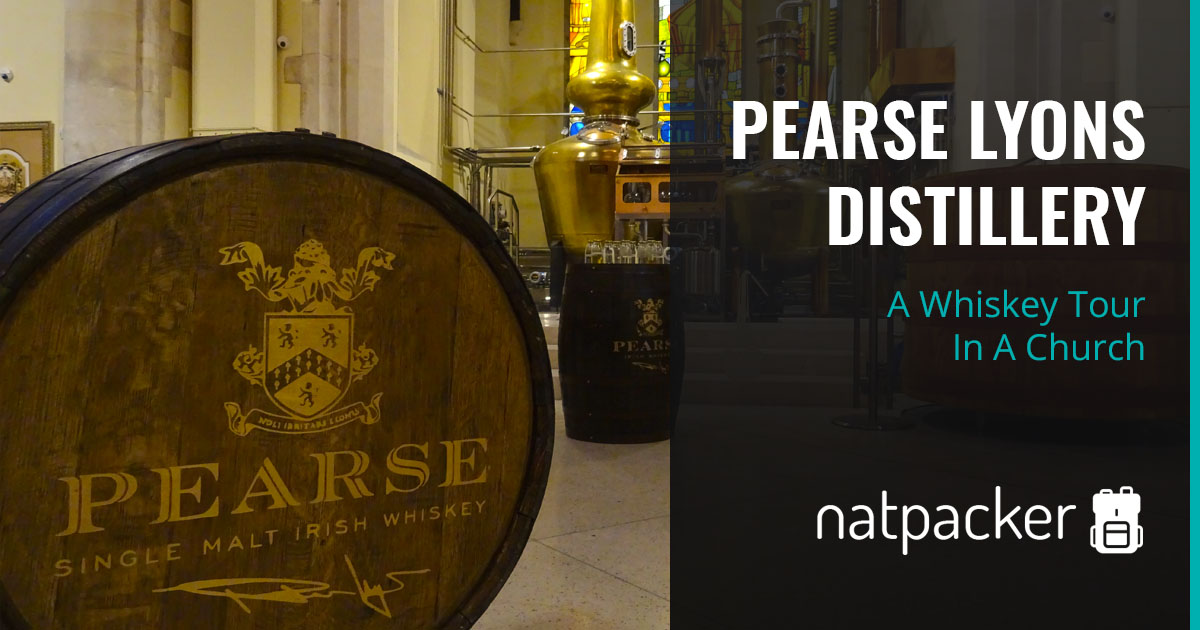If you don’t know, I’m a whiskey girl. It took me a few trips to Scotland, but now whisky is my tipple of choice. That being said, I always reached for Scottish Whisky over Irish. I love and Oban, which I discovered on my honeymoon. So when I was in Dublin I had to try some Irish whiskey. Therefore I had to do a distillery tour and for this, I went to Pearse Lyons.
Disclaimer: I was hosted on the Pearse Lyons Distillery tour in exchange for unbiased coverage. Therefore all opinions in this post are my own and uninfluenced
We had an early afternoon tour booked, so we had a bit of a lazy morning (we had just got back from a Shamrockers tour (click here for reviews) the night before, so we were a bit worn out!) So after a wonderful breakfast/brunch from Veginity (reviews are here), we headed out to the distillery.
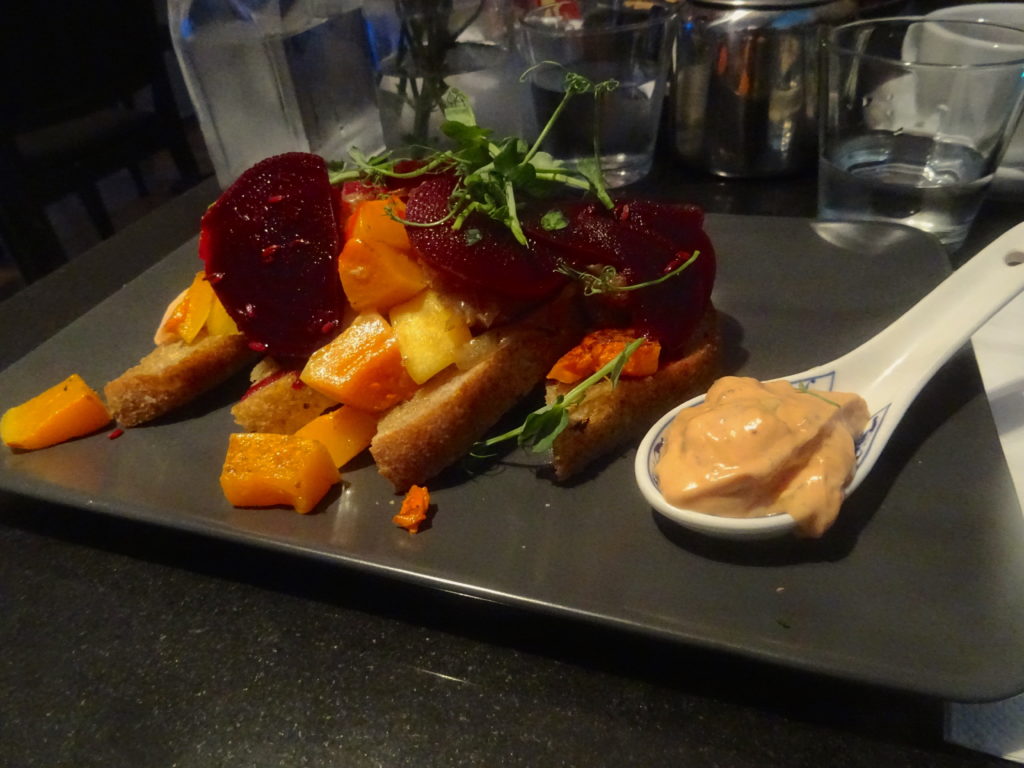
A Yummy Breakfast/Brunch
I was quite impressed that despite our lazy morning, we managed to get to the distillery early for the tour. Pearse Lyons Distillery (follow this link for reviews) is pretty easy to find. It’s in a church, so you can’t really miss it! As we approached, I noticed the glass spire. It’s a beautiful building.
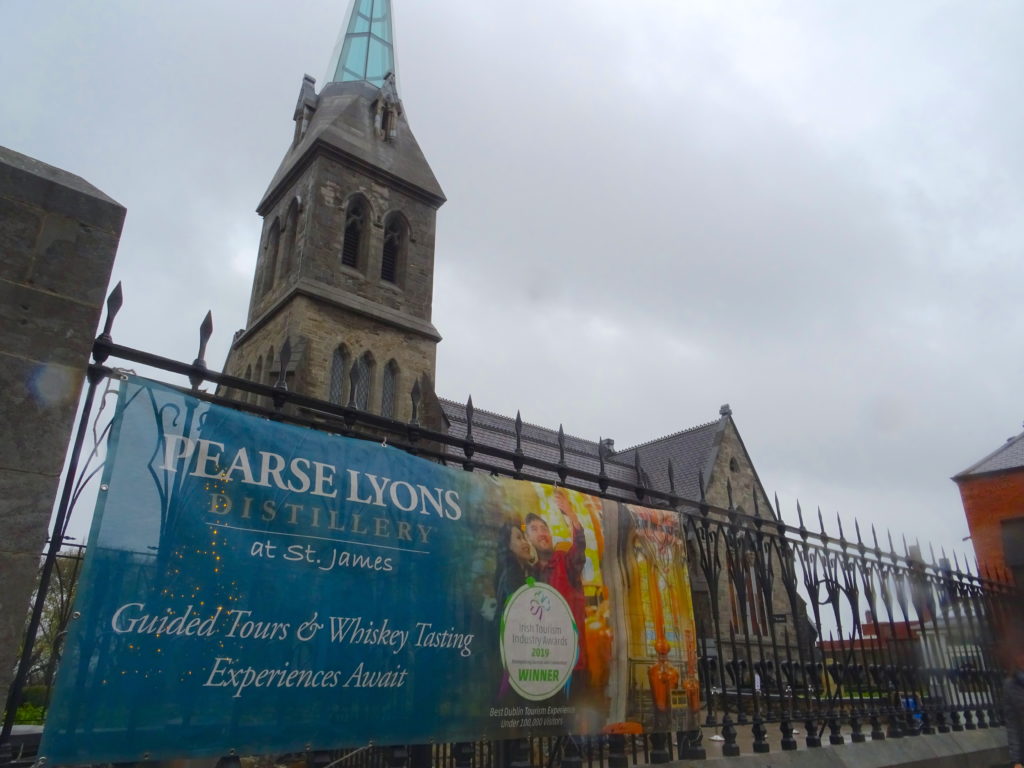
My First View Of Pearse Lyons, You Can’t Miss The Distillery
Pre Tour Fun
The church isn’t actually the entrance for the distillery tour instead, you go into the building next door. You can’t miss this either, it has Pearse Lyons Distillery written on it in huge letters!
On entering we were given our tickets and a wristband each from the front desk. As we had time to wait the lady let us through into the waiting area. On the back wall, there are a load of quotes about whiskey from people such as James Joyce and Mark Twain.
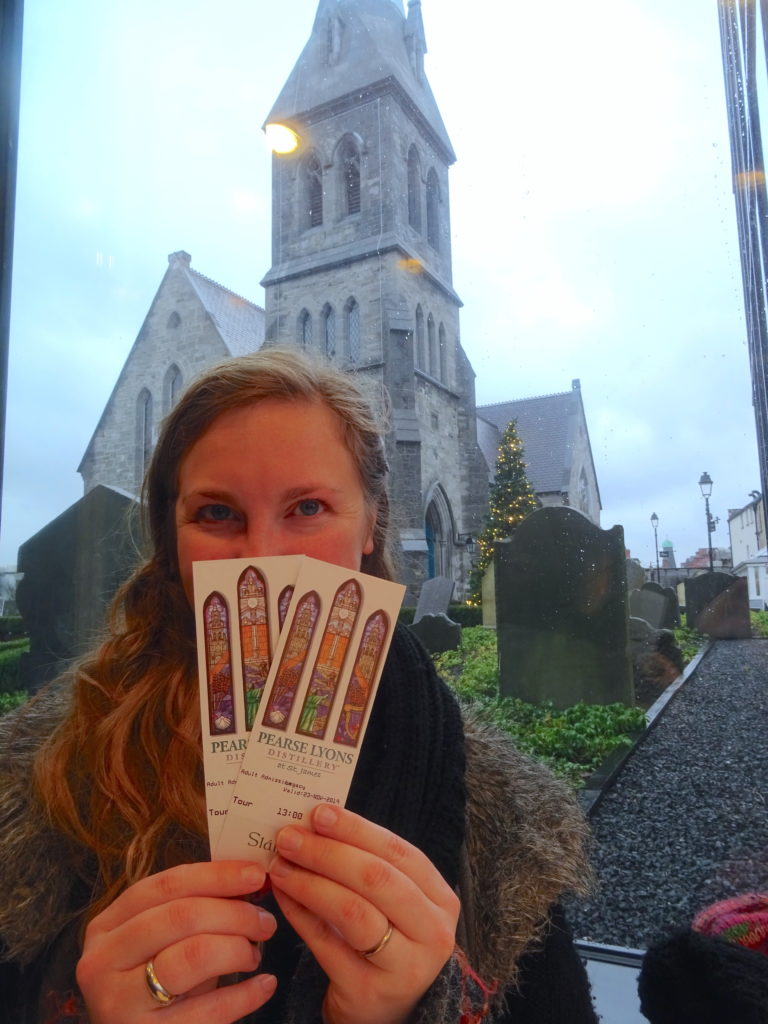
Tickets In Hand, Ready For The Tour
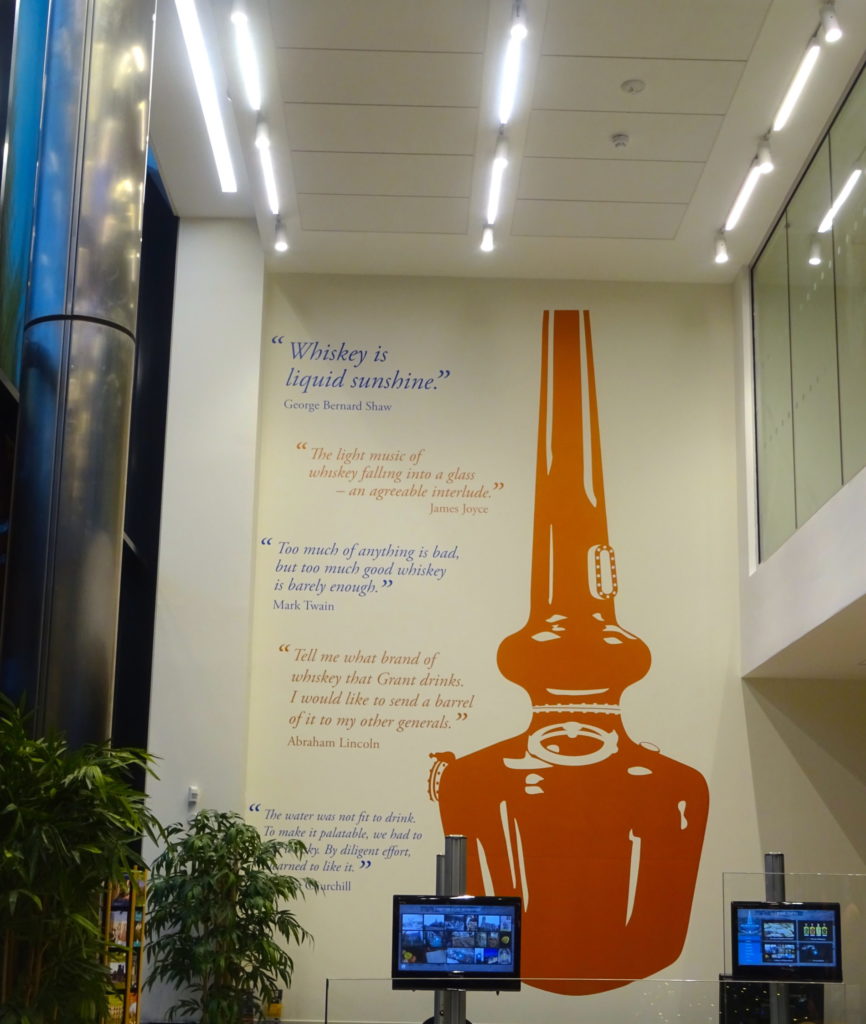
The Waiting Area At Pearse Lyons
Whilst you wait there are interactive screens to play with. You can use them to learn a few things about whiskey before your tour. There’s also a little quiz you can do. Turns out I was a whiskey expert before I even did this tour! (To be fair, I think this must be at least my fifth distillery tour).
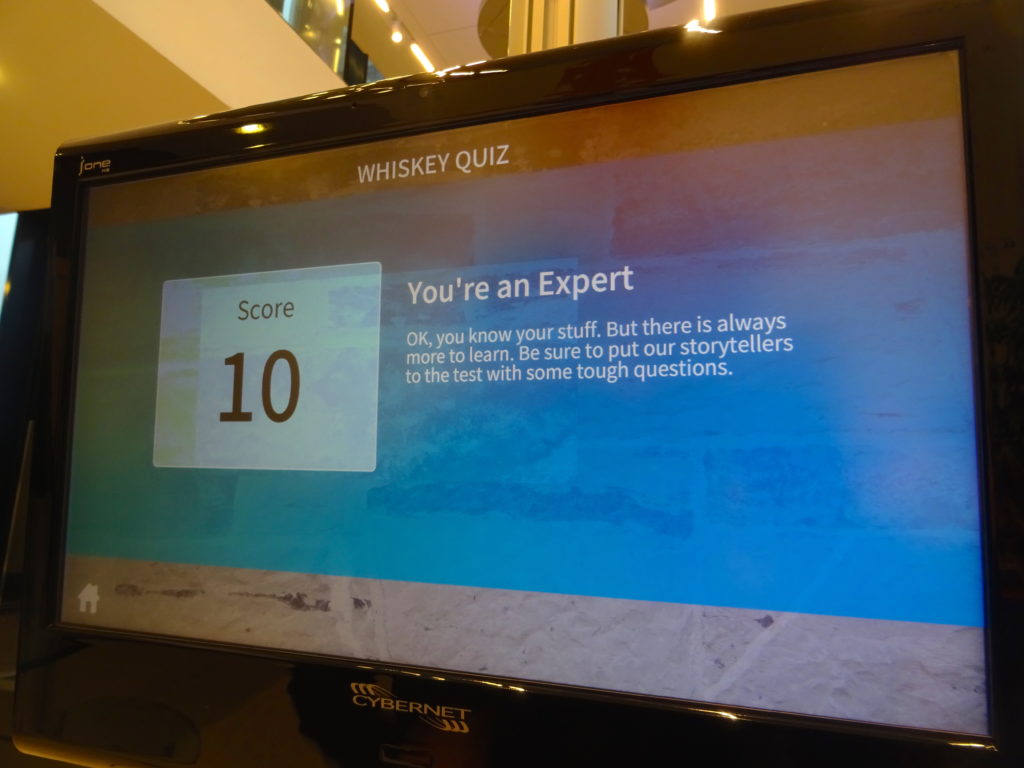
Does This Mean I’ve Done Too Many Distillery Tours?
Pearse Lyons Distillery Tour
It wasn’t too long of a wait before our tour started. Soon the guide appeared and we began the distillery tour of Pearse Lyons.
Our guide introduced himself as David and gave us a brief overview of what we can expect on the tour, plus some little bits about whiskey. He also told us that whiskey was invented so that the Irish didn’t take over the world.
An Introduction By Pearse Lyons
David led us into a small room with seats. The first part of the tour was a video, in which Pearse Lyons himself talked about whiskey, the distillery and more.
Pearse Lyons actually died in 2018, so it’s nice that they still have this introductory video starring the man who is behind this distillery.
The video went into a lot of detail about a lot of things. Pearse Lyons spoke about St James’ Church (that the distillery is in) and its link to the Camino de Santiago. Across the road in the new St James Church, you can get a passport and help with this pilgrimage. He also told us that the church was once part of St Thomas’ Abbey, which was founded by Henry II in penance for the murder of Thomas Becket.

Pearse Lyons Buildings
The Golden Triangle Of Dublin
The Church of St James that the distillery is located in has a family connection to Pearse Lyons, which is why he made the distillery here. Nine of his family members are buried in the graveyard. He also has a link to whiskey as some of his ancestors were coopers.
When I went (2019), it was still a very young distillery, as it had only been open for two years, though it had been distilling since 2013. The location of the distillery is in what is known as the “Golden Triangle”. Within this one mile radius, there were once around 40 distilleries. The big names in Irish whiskey are all found here; Jamesons, Roe and Powers. Irish whiskey had a bit of a rough time in the past and is currently being revived (which I guess makes sense for me generally preferring Scottish whiskey, I’ve just tried a lot more brands as many more brands exist).
The Dublin Golden Triangle is located in an area known as the Liberties. This area is known as an area of expertise, as once you would have found many industries here such as tanning, silk weaving and silverwork.
Making The Church A Distillery
Turning the church into a distillery was no easy task! The church itself had to be restored, which was undertaken by Pearse Lyon’s wife, Deidre. Once the building was ready, it was time to get the stills inside.
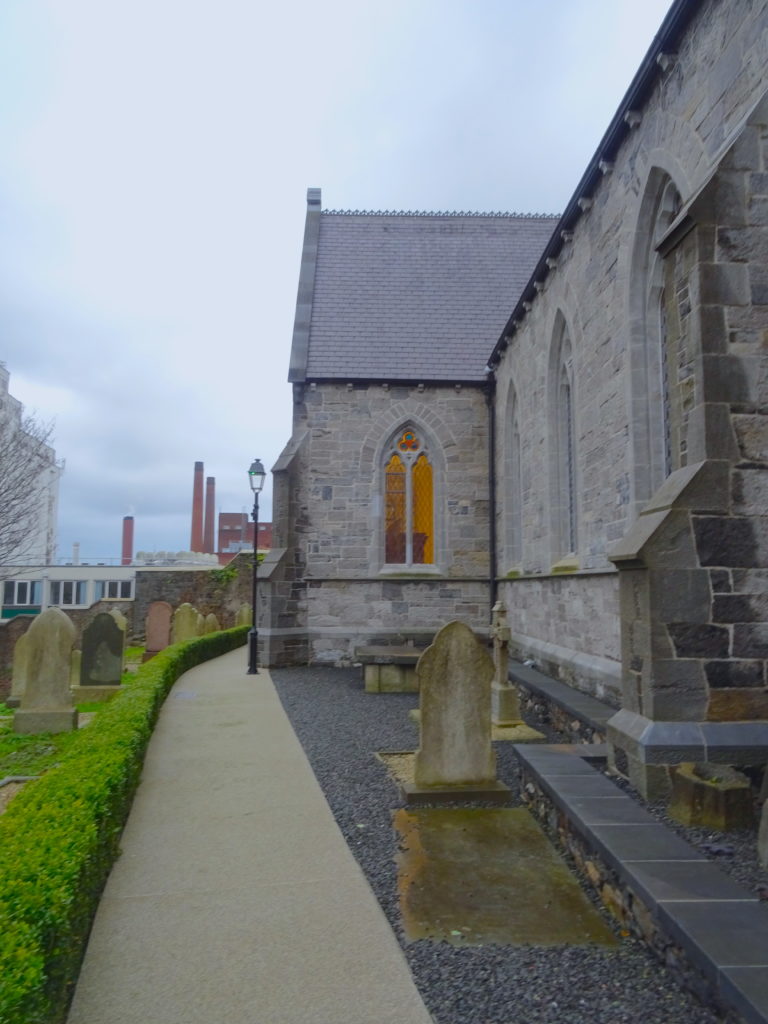
St James Church Now Houses Pearse lyons Distillery
The two small-batch copper pot stills were made in Kentucky, USA, and so had to be moved into the church. However, they were too big to get through the doors. The roof of the church had to be taken off and the stills air-lifted in. So now the stills have pride of place, nestled in the sanctuary.
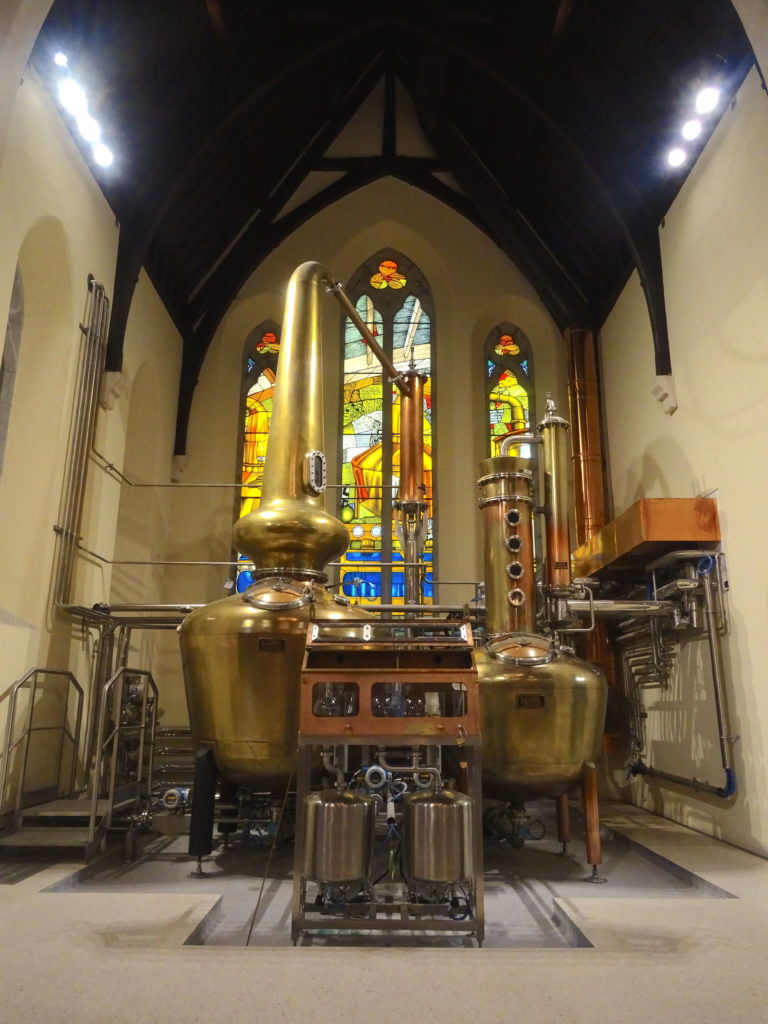
The Stills Take Pride Of Place In The Distillery
One interesting feature of the church-come-distillery is the steeple. The original steeple was struck by lightning and so had to be removed due to safety concerns in 1948 (the church was still being used for worship then). Pearse Lyons has rebuilt the steeple but in glass. It is referred to as the “Liberties Lantern”, and is often lit up for various events.
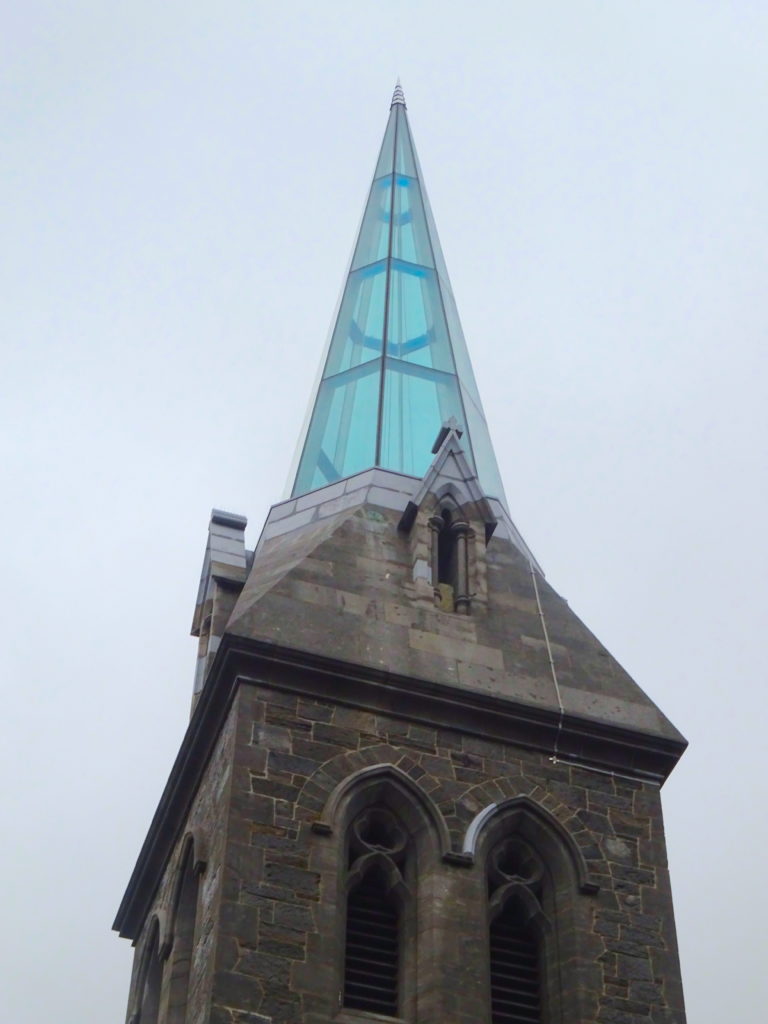
The New Church Spire At Pearse Lyons Is Made From Glass

The Full Tower And Spire
The video also told us a little about the archaeological interest of the site. Although the graveyard is small, 200 full bodies have been found, and the same number of partial bodies. The graveyard is still an active archaeological site, so who knows how many bodies will be found!
David Tells Us More
After the video had finished David led us from the room and up the stairs. We were essentially led into a corridor that had a view of the church and graveyard. Here David told us a few more stories and gave some more details on what the video told us.

St James Church Now Houses Pearse Lyons Distillery
The History Of St James’ Church
The church itself has quite a colourful history, which David told us about. It has been both a Protestant church and a Catholic church at different points in its history. When the church was Protestant Catholics had to perform their rites of passage outside the church at a fountain.
In 1816 St James was Protestant, the current church on the site was built in 1859 – 1860, and so was Protestant. It was around 100 years later that this church closed its doors. Though the church building was used as various shops for a few years before it closed fully.
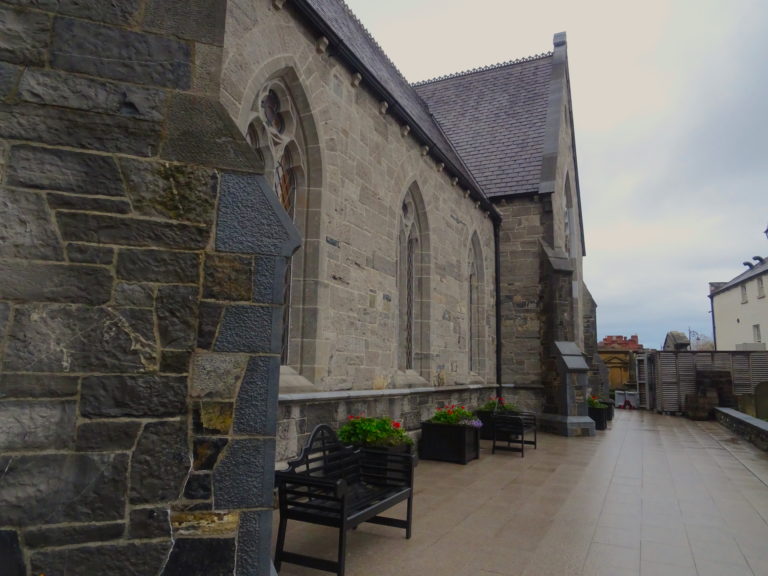
We Were Told The History Of St James Church On The Tour
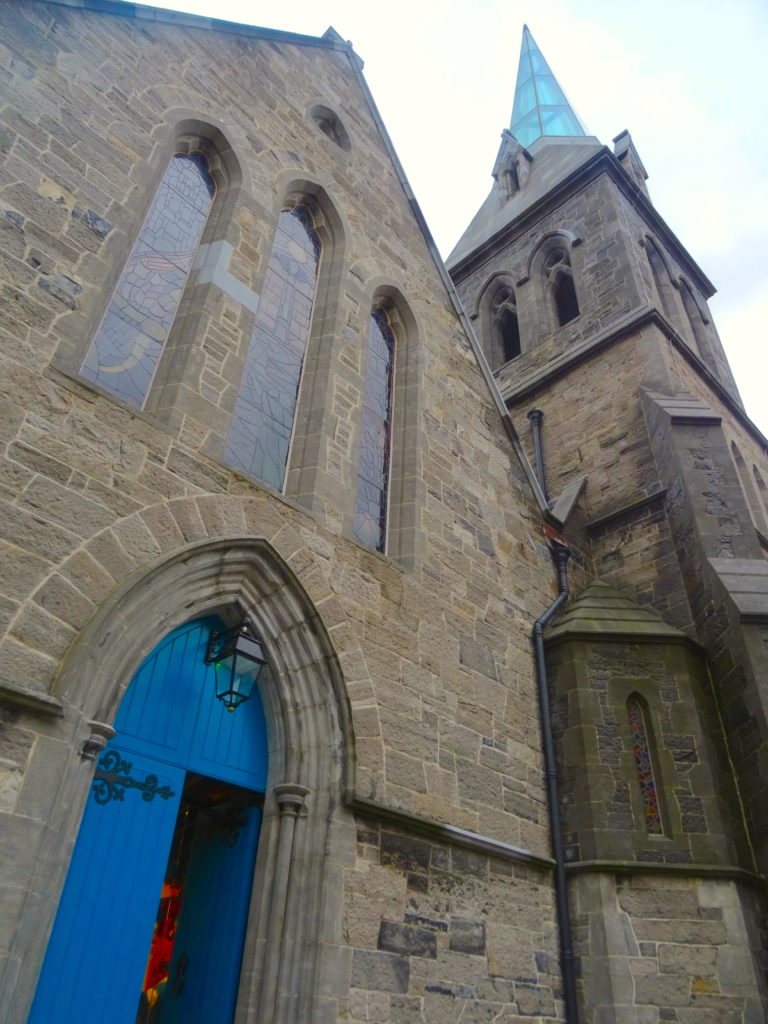
St James Church Entrance At Pearse Lyons
Pearse Lyons felt responsible for the church that was now completely run down as he had family members buried in the graveyard, including his Grandad and Great Grandad. This is why he chose the church as a location for a distillery; he felt linked to it and wanted to see the church repaired.
The Graveyard
As we had a good view of the graveyard, David told us a bit about it and the people buried here. I think this is usually done in the graveyard itself, but it being November I don’t think anyone would have been too impressed to be stood outside for so long!
The graveyard itself s actually 2 acres. It is believed that there are 210,000 – 220,000 bodies in these two acres. Sounds like a lot, doesn’t it? The bodies are buried on top of each other, thousands are piled on top of the other, which is how some many fit in. This is the same for many old graveyards, I was told about this in Greyfriars in Edinburgh too.
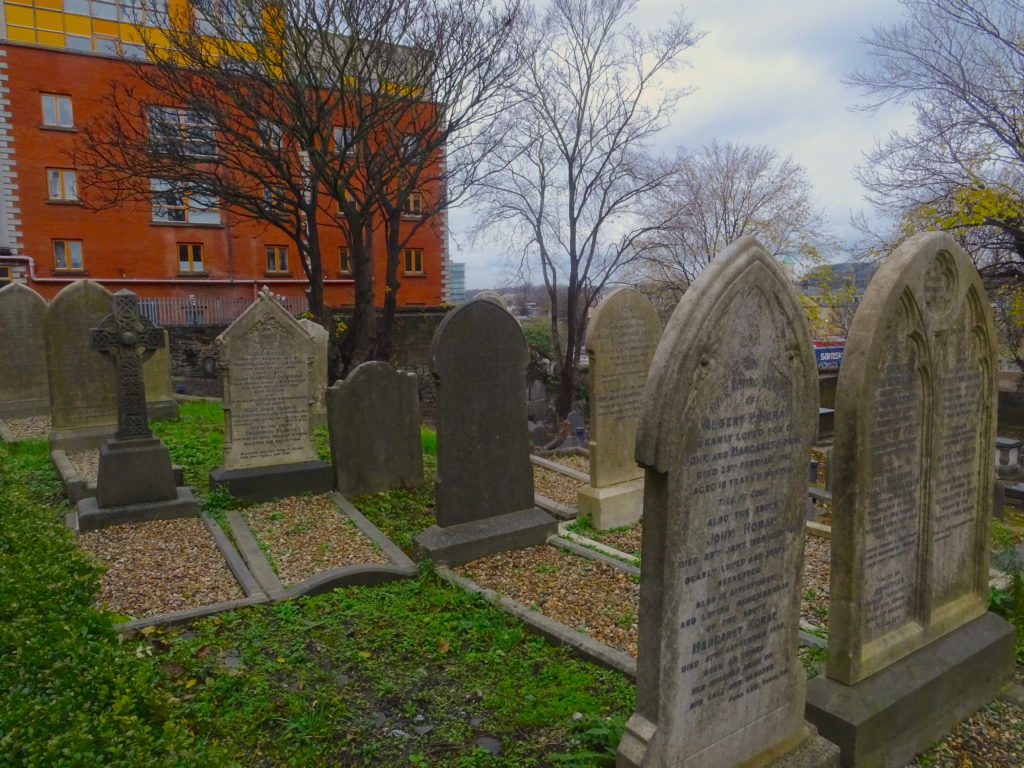
The Graveyard Looks Small, But Thousands Are Buried Here
Another reason it looks like a lot less is the fact the only the richer people have headstones. So if you count the headstones you do not get a true amount. About 99% of the people buried in the graveyard are in unmarked graves.
Headstone Symbols
Headstones are really interesting, don’t you think? Especially old headstones. They tell you a lot. For instance, in St James graveyard, any headstone that has the skull and crossbones on it signifies that the person died from disease.
Another interesting point on these headstones is the use of the Celtic Cross. I mean, obviously the Celtic Cross is used being in Ireland, but it is the Celtic Cross itself that has an interesting history. The cross also features a circle, which is the pagan symbol for the sun. It is believed that St Patrick invented this cross, which incorporated the pagan symbolism, to help the pagans in Ireland to be convinced to become Catholic.
Grave Robbing
Just like every old graveyard, St James was not safe from grave robbers. Back in the day if you could provide a fresh body to medical schools for scientific research you would be paid about one years wages. Is it any wonder people started digging up bodies?
Old churchyards tend to of had different ways to deter graverobbers. In Greyfriars Kirkyard they used cages (mortsafes) placed on top of the fresh graves. Here in St, James’ large stones were placed on top of the fresh graves.
The graverobbers had quite the system to retrieve a body. I suppose when it’s worth so much money, but very risky (although you would usually only get a fine if caught, the guard would have a shotgun), you have to be clever about it.
So what would happen is that the wife of the would-be graverobber would scope out potential targets by crashing funerals. She would turn up as a mourner to any funeral taking place. Then after the funeral was over she would throw some broken glass on the grave that was worth taking the body from.
At night the husband would sneak into the graveyard and his torchlight would reflect off the glass that his wife had thrown, so he knew which body to dig up. The body snatcher would dig from the headstone at a 90-degree angle. This would expose the top of the body (which would be wrapped in white linen). Hooks would be placed under both the shoulders and the body pulled out. All that was left was to then sneak past the guard again and then throw the body over the wall.
Theobold Butler
David pointed out the largest headstone in the graveyard; this belongs to Theobald (Toby) Butler.
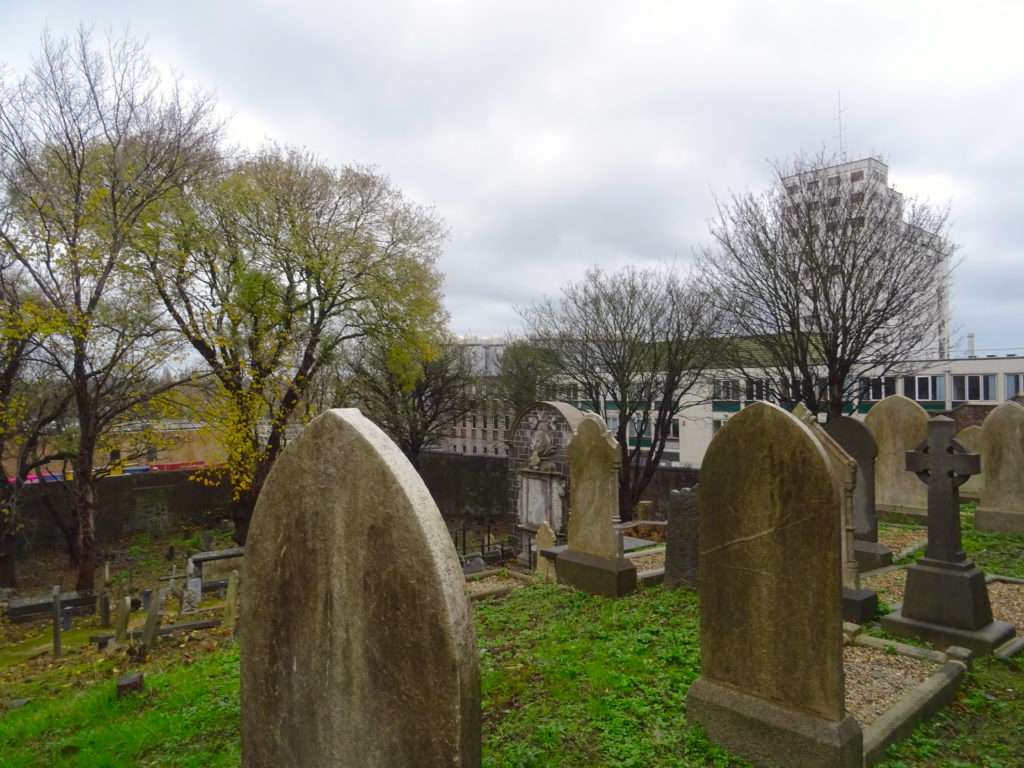
The Large Gravestone In The Background Belongs To Theobald Butler
This man was born in 1650 and became one of the most sought after barristers in Ireland He was known for getting drunk before his cases, but he vowed that he “never touched a bottle before making a plea.” And to be fair, this was true; he dipped bread in wine. So technically he didn’t touch a bottle. Despite his drinking, he had the reputation of being a very good lawyer.
But this isn’t all that Theobald Butler is known for. He helped to draw up the Treaty of Limerick, which was meant to block Penal Laws. Although the Parliament of Ireland chose to ignore this treaty and Penal Laws were still imposed against Catholics. Because of this Butler converted from Roman Catholic to Protestant purely so that his children could inherit when he died.
Peg Plunkett
Another notable character buried in St James is Peg Plunkett. This woman lived in the 1700s and was one of twenty-two children (although only eight survived to adulthood). She had a bit of a rubbish start to life, as her father was ill and her mother died, this led to her older brother becoming the head of the house. Unfortunately, he was abusive, so Plunkett ran away to Dublin.
It looked like things would get better in Dublin. By the age of sixteen, she had a wealthy landlord as a lover. When she became pregnant, the landlord decided to look after her. Unfortunately, she miscarried and so her lover kicked her out. This wasn’t the only child that Plunket was destined to lose, in total she lost six children.
After this Peg Plunket began to make her own luck. She became a prostitute and ran her own brothel. Her girls were known as “nymphs” and she ran one of the most successful brothels in Dublin.
Peg Plunkett was a well-known character in Dublin. As her brothel was so successful, she could afford to go to the theatre, where she would happily sit next to her patrons’ wives. It is also said that people would try to insult her by asking who she slept with the night before. But Peg would not be fazed and would reply “don’t be so rude you dogs.”
Peg Plunkett And Pinking Dindies
One of the most famous escapades of Peg Plunket was being successful in court against the Pinking Dindies.
The Pinking Dindies were a gang of upper-class youths and failed students, led by Richard Crosbie. The gang were known for attacking brothels, as well as just generally mugging. The gang attacked Plunkett’s brothel and led to her losing an unborn child. Peg Plunkett took Crosbie to court and won the case. Plunkett had a lot of local support as her brothel drew people in, who would then spend money at the other businesses nearby.
As she got older, she began to write her memoirs. A clever move for an old prostitute. It is believed that she intended to blackmail former lovers and clients with it.
Whiskey In The Liberties
In the graveyard, you will notice that the stones on the wall have numbers on them. Those stones with numbers are from the original stones from the wall, which is also the boundary wall of the Liberties. If any of the original stones fall out, they can be put back in the correct place using the number system. The wall was rebuilt as close to the original as possible.
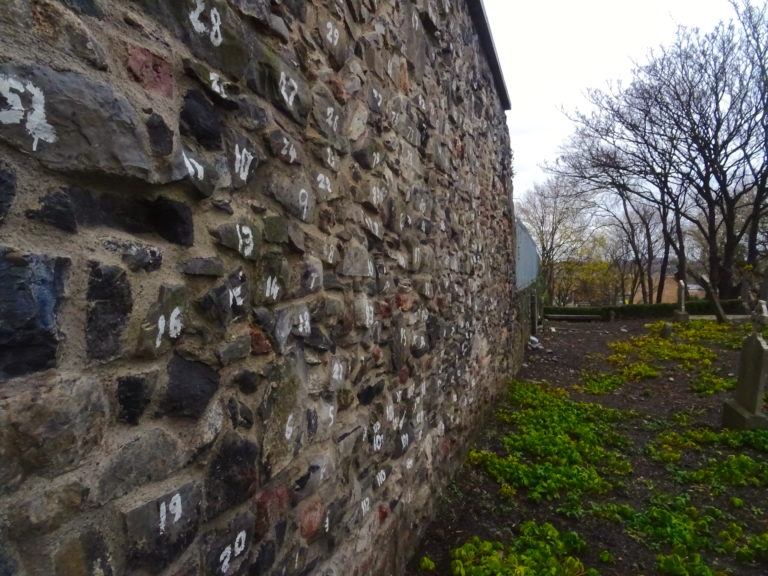
The Numbered Stones Are Original Pieces Of The Wall
The Golden Triangle in the Liberties was once well-known for Irish Whiskey. I was surprised to be told that in its heyday Roe’s produced more than Jameson’s, simply because Jameson’s seems to be the most well-known nowadays.
Roe’s Distillery was once just up the road from where Pearse Lyons is now. You can still see St Patrick’s Tower, which was a brick-built windmill. This tower is believed to be one of the oldest smock windmills that survives in Europe today.
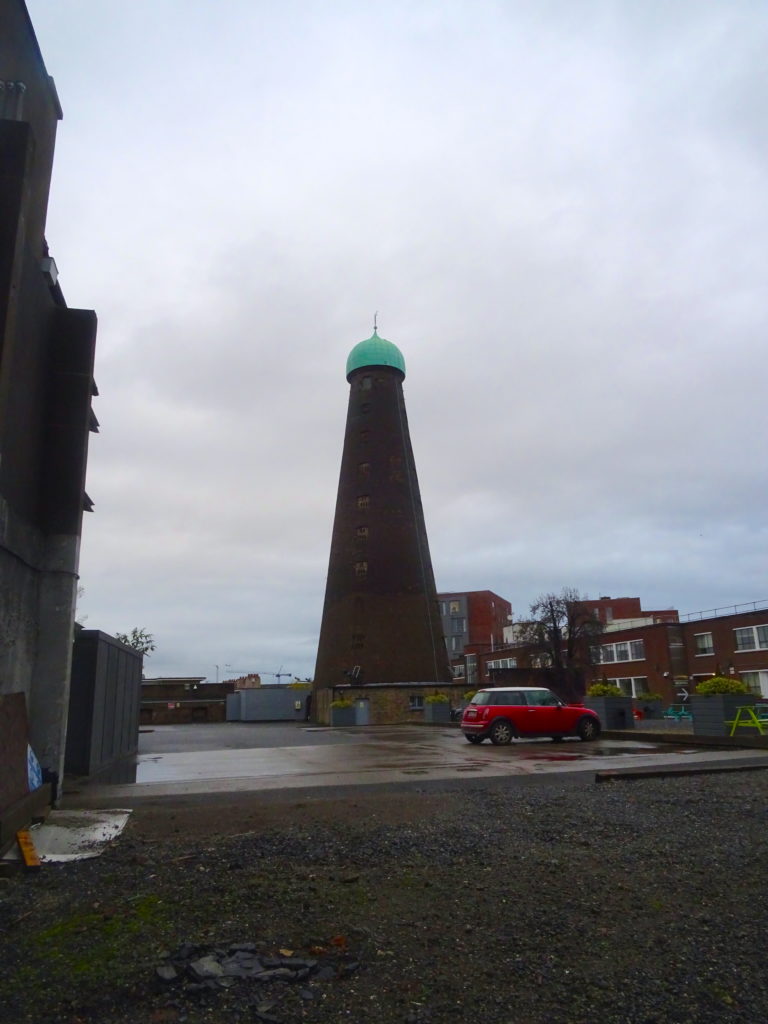
St Patricks Tower Is Just Up The Road
Unfortunately, it wasn’t just whiskey to be made in this area, there was also Guinness. I say unfortunately as Guinness and Roe didn’t get on. In fact, Guinness didn’t generally like whiskey and said that “whiskey is the blight of mankind”. Therefore when Roe’s went bust, Guinness bought the distillery. But there was clearly a bit of rivalry between Guinness and Roe, as Roe gave money to Christ Church Cathedral for restoration, so Guinness gave money to St. Patrick’s.
The Liberties Revival
Unfortunately, in the 1900s the business of Irish whiskey began to decline. This was due to various factors such as wars (including a trade-war with Britain), the introduction of blended whiskey and prohibition in the USA (which stopped exports to the second-largest market). These factors and more caused a huge decline and in the 1970s there were only two distilleries operating in Ireland.
Luckily, there has been a resurgence, causing Irish Whiskey to be the fastest-growing spirit in the world. Distilleries reopened and new ones sprung up. With this resurgence, the Golden Triangle and the Liberties have had a revival. In June 2019 there were twenty-five Irish whiskey distilleries and it was hoped that there would be thirty.
The Distillery In St James’ Church
Back down the stairs and into the graveyard we went. We didn’t hang around here as it was a bit cold but instead headed into St James’ Church.
On entering there is a little area before you enter the main church. Looking up you can see right up into the spire.
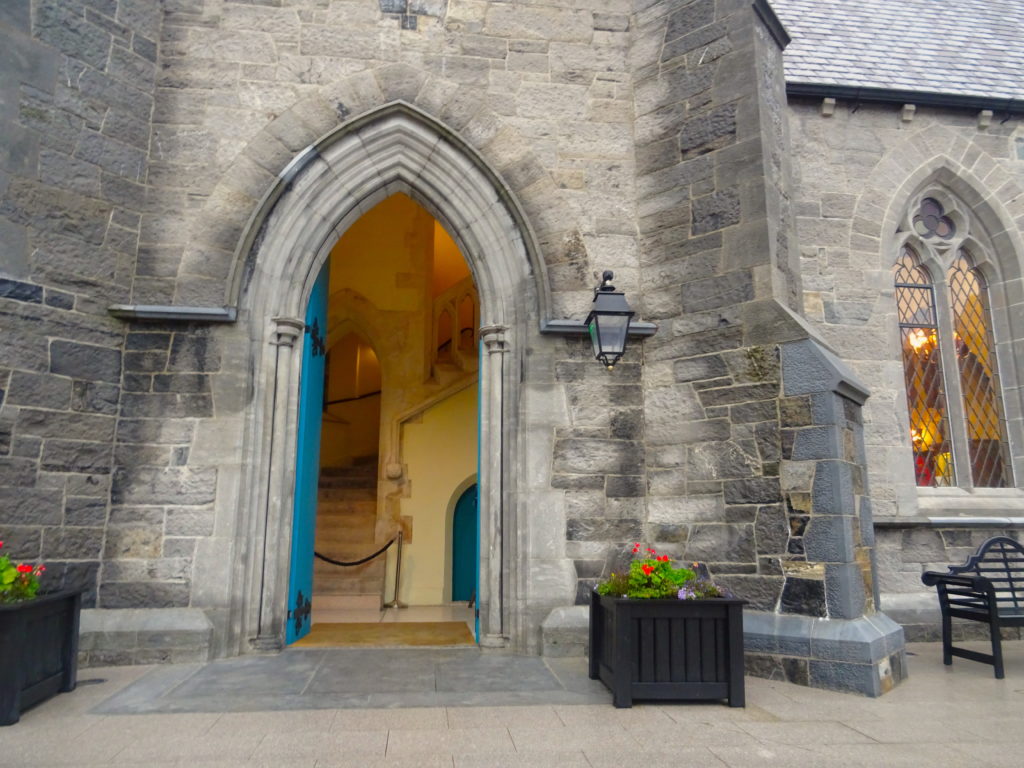
Even The Entrance Was Pretty
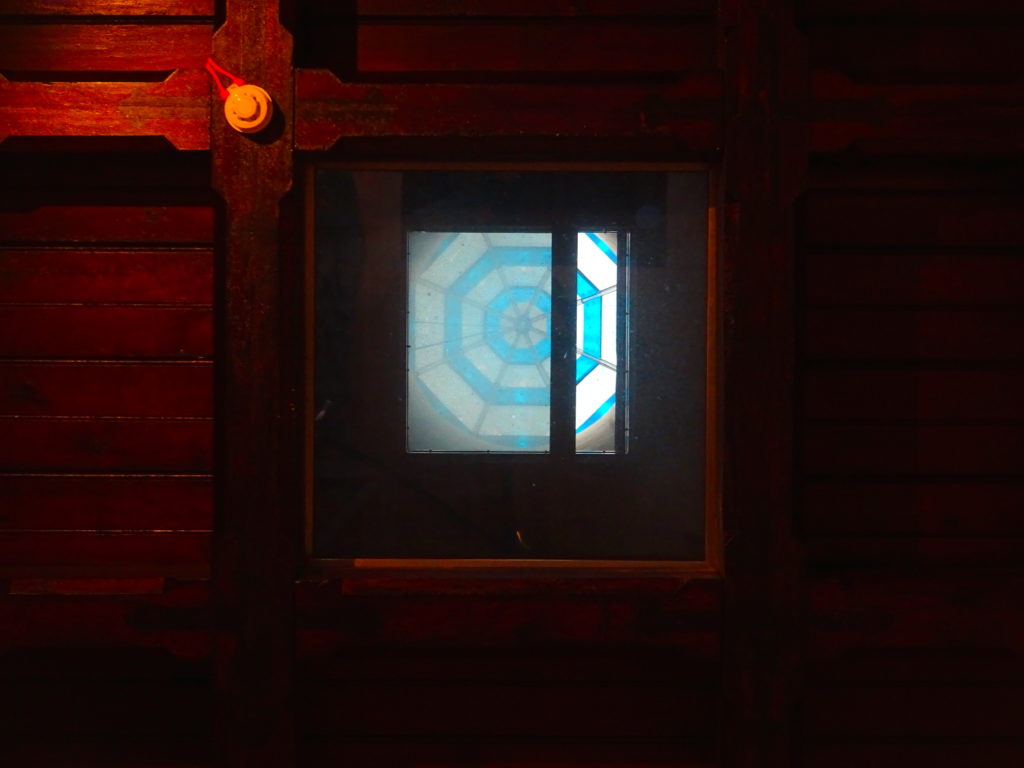
Looking Up Into The Glass Spire At Pearse Lyons
Going into the main church, it is all open plan. Walking in there are displays on either side, two whiskey stills at the far end, a bar and a shop. It is the smallest distillery I have ever been to, but they really make good use of the space and the church feels open and airy. Very different from other distilleries where tours take you through various small rooms.
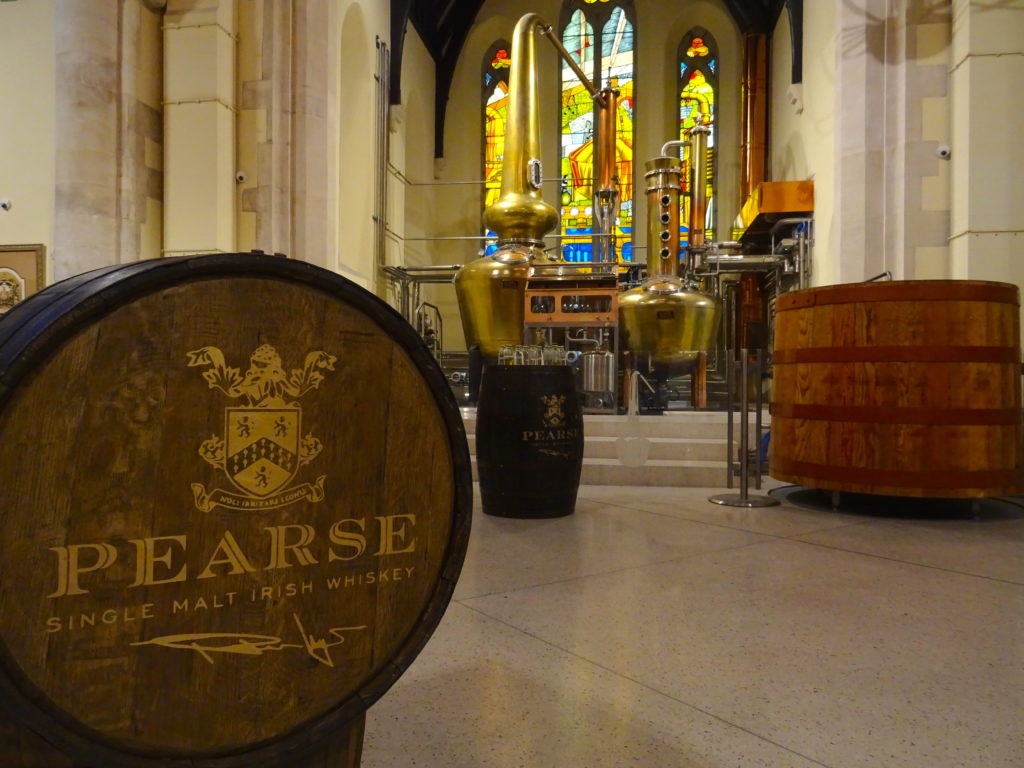
The Distillery Is All In The One Room Of St James Church
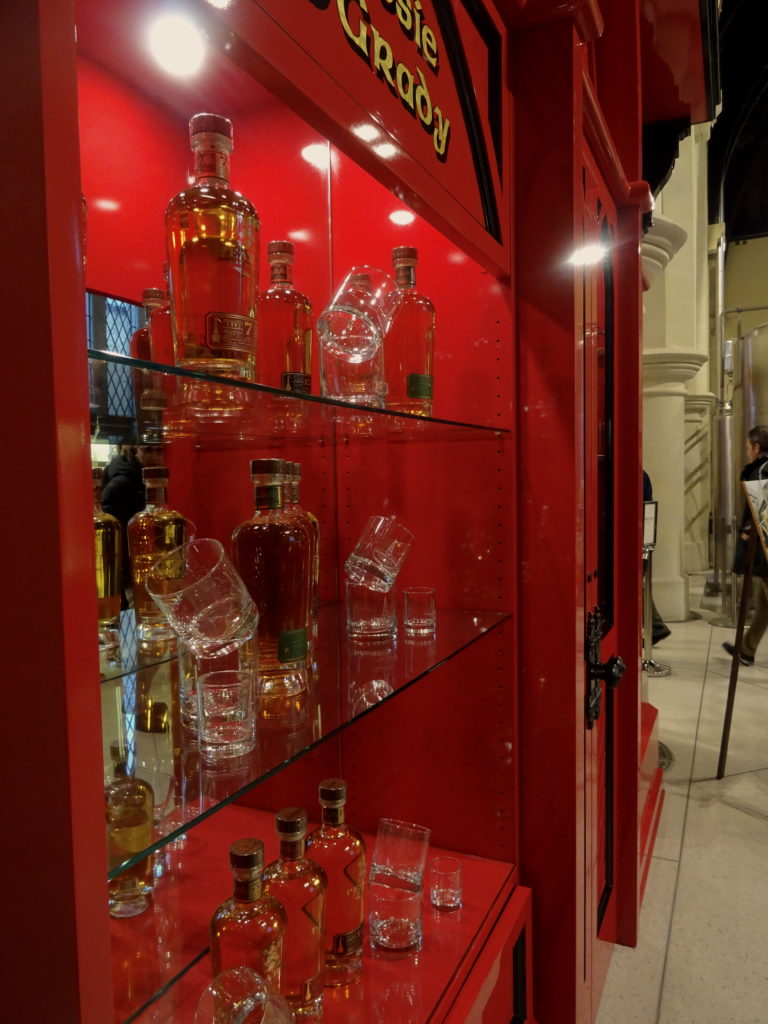
The Entrance Has Various Whiskey Displays
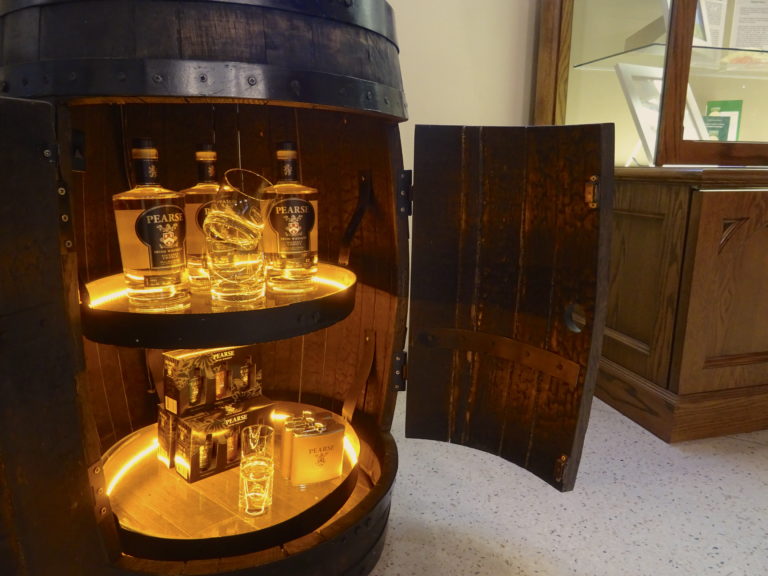
The Whiskey Displays Are Eye-Catching
The Stained Glass Windows
As we entered David started to tell us about Pearse Lyons Distillery. The renovation cost around £22 million. This distillery (at time of writing) is the only independent, family-run whiskey distillery in Dublin.
The stained glass windows in the church are incredible, David pointed them out to us. It was Deidre Lyons (Pearse’s wife) who designed the new windows. The designs show images linked with St James, coopers and whiskey. Two really caught my eye at this point and we were told a little bit about them.
One stained glass window shows the Camino de Santiago or St James’ Way. The window with this imagery is in three parts, one shows a path with a pilgrim, one shows symbols of St James like the scallop and the other shows Ireland symbols, like the harp. One interesting thing David told us here is that Ireland is the only country to have an instrument as its symbol.
The other window that we were told about is above the bar. This one shows a cooper. The cooper shown is actually a local man, Robert Dunne, who was a famous cooper. He completed his seven-year apprenticeship and became a master cooper within 10 years. This is very fast for becoming a master cooper.
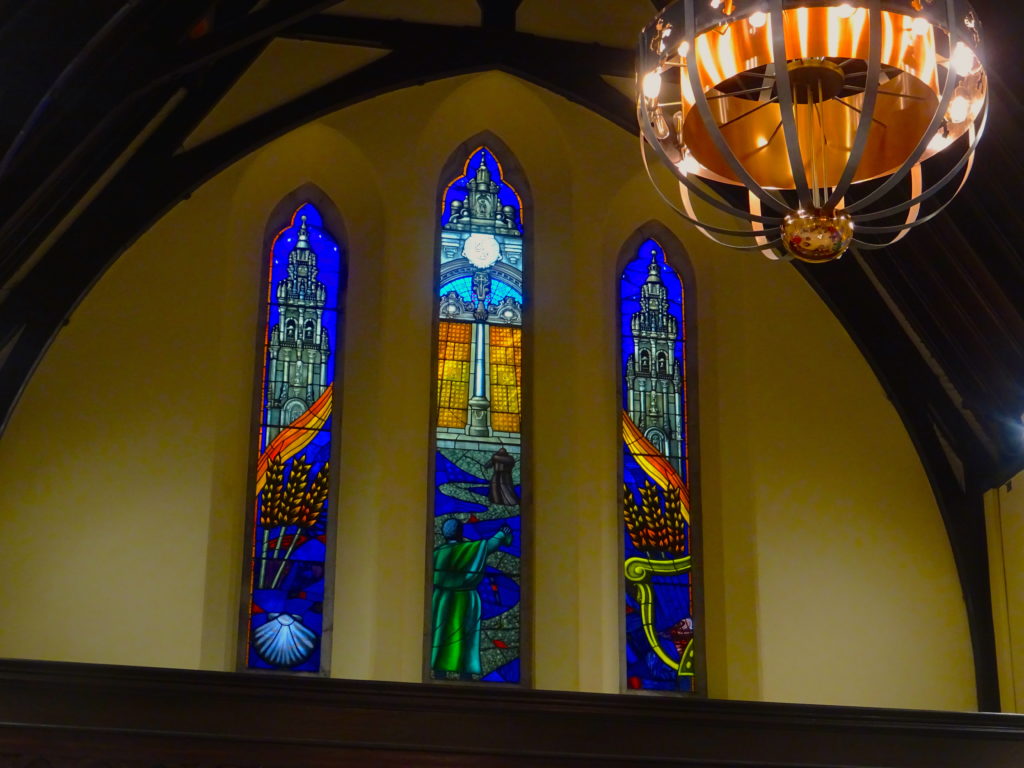
Camino de Santiago Stained Glass Window
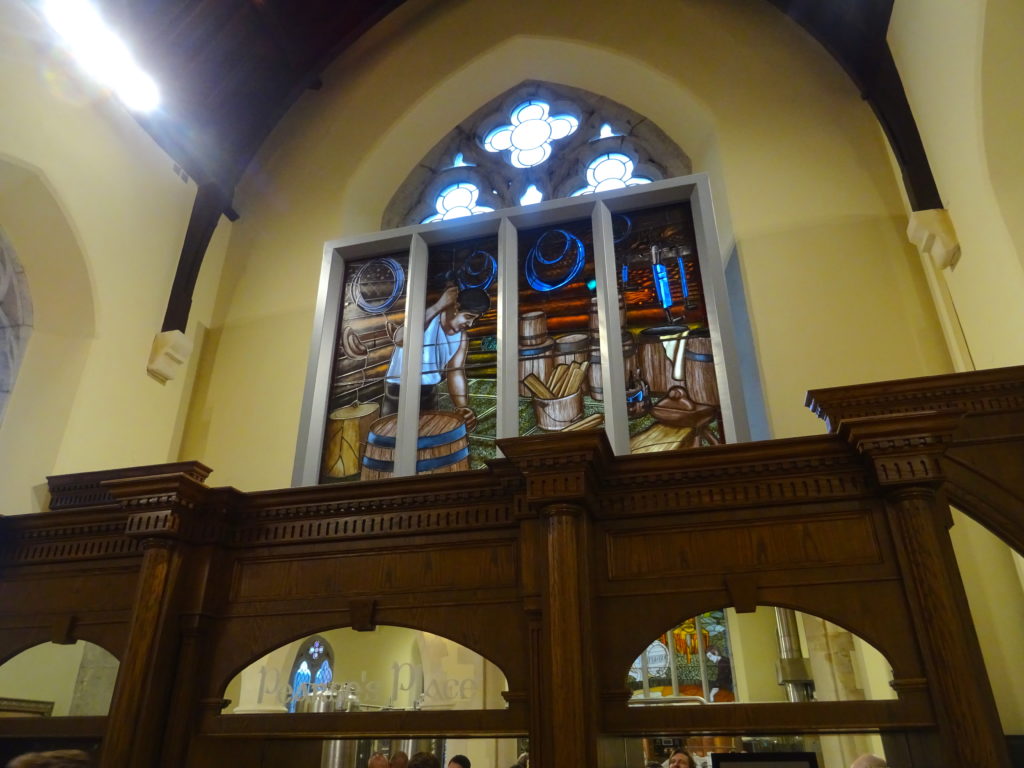
The Window Above The Bar Shows A Cooper
The Whiskey Process
Whiskey is a historic drink in Ireland. It has been recorded in Ireland since 1405. The distilling process actually comes from the Middle East, where it was used to make perfume.
The tour took us through the process of making whiskey, and I honestly thought it was one of the best explanations I have had. It was nice to no be shepherded from room to room and for everything to be in one place.
David told us that the start of making whiskey is to actually produce beer. You then take the ‘spirit’ from the beer, which is where the word for such drinks comes from.
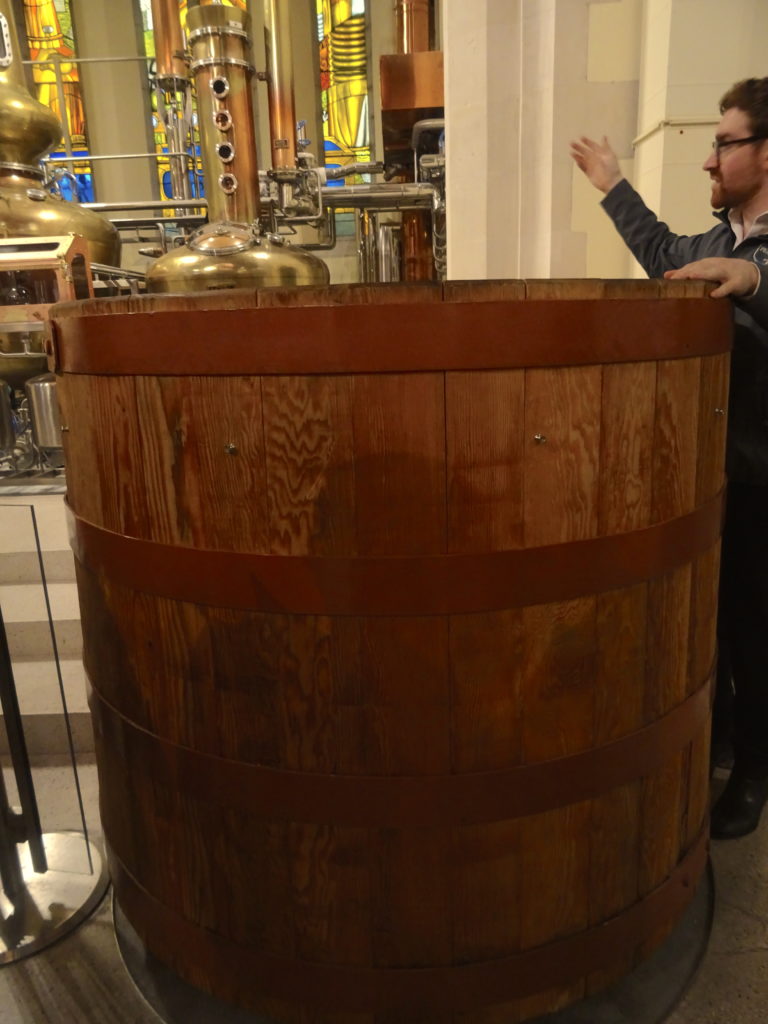
Our Tour Guide, David, Told Us About The Process Of Making Whiskey
Beer And Spirits
The whole process started with barley. David had a number of jars to pass around that showed barley at different parts of the process. This allowed us to look and smell the differences as he told us the process of making whiskey.
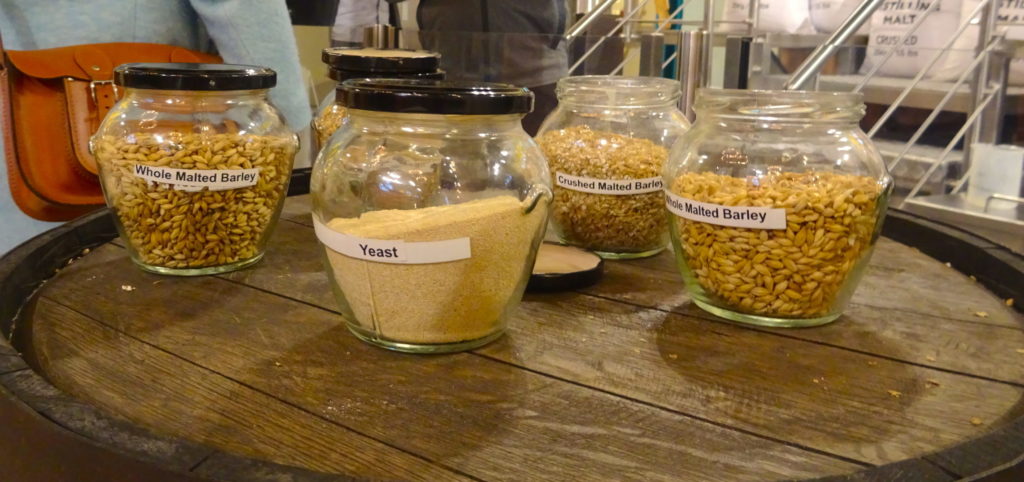
The Jars Of Different Barley
The barley is first malted, which removes the sugar. This malted barley is then crushed to create grist, which is then put in water at 60℃ for ninety minutes. The mash that is left over is sold on for animal feed.
Leftover is some sugary water. This water is mixed with yeast at 20℃, which makes beer. The beer is only about 7% alcohol and is called wash.
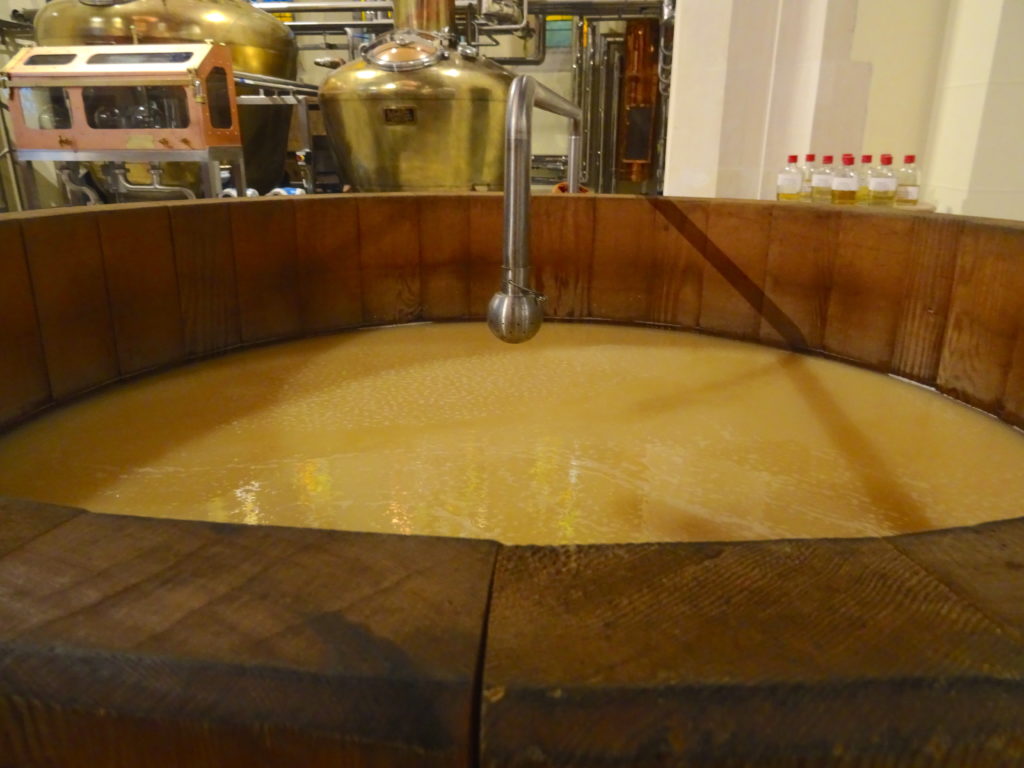
Barrel Of Wash
Mighty Molly And Little Lizzie
After making this weak beer, the whiskey stills come into play. Pearse Lyons only has two stills, which are named Mighty Molly and Little Lizzie. These have been named after family members.
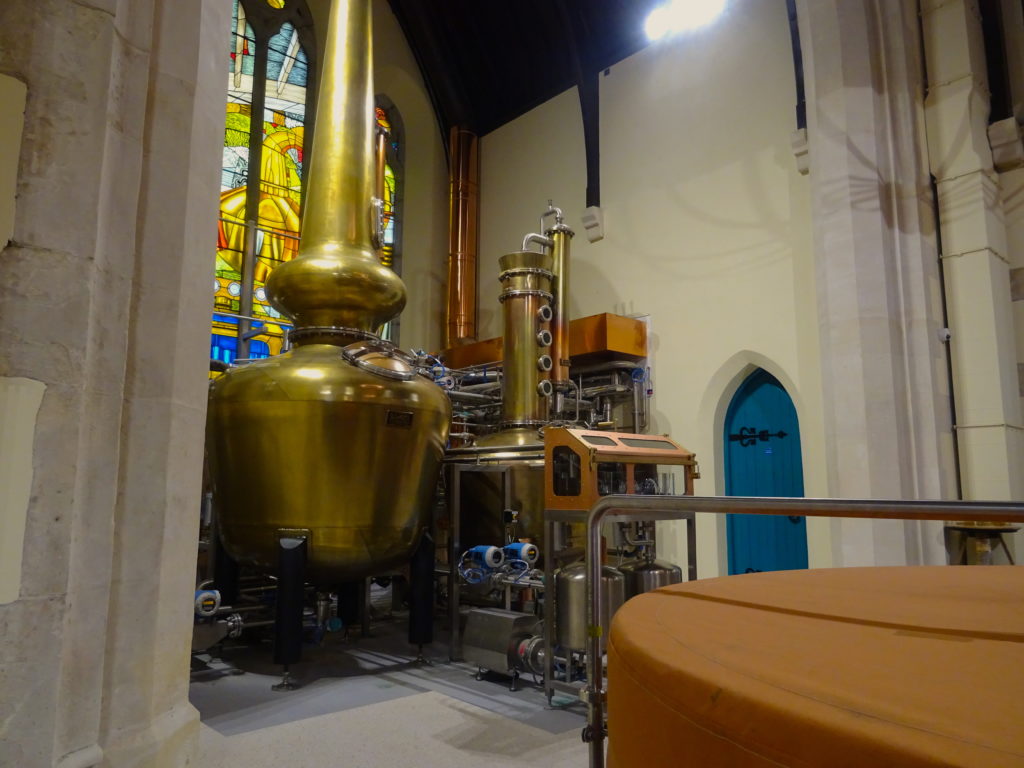
The Stills At Pearse Lyons Distillery
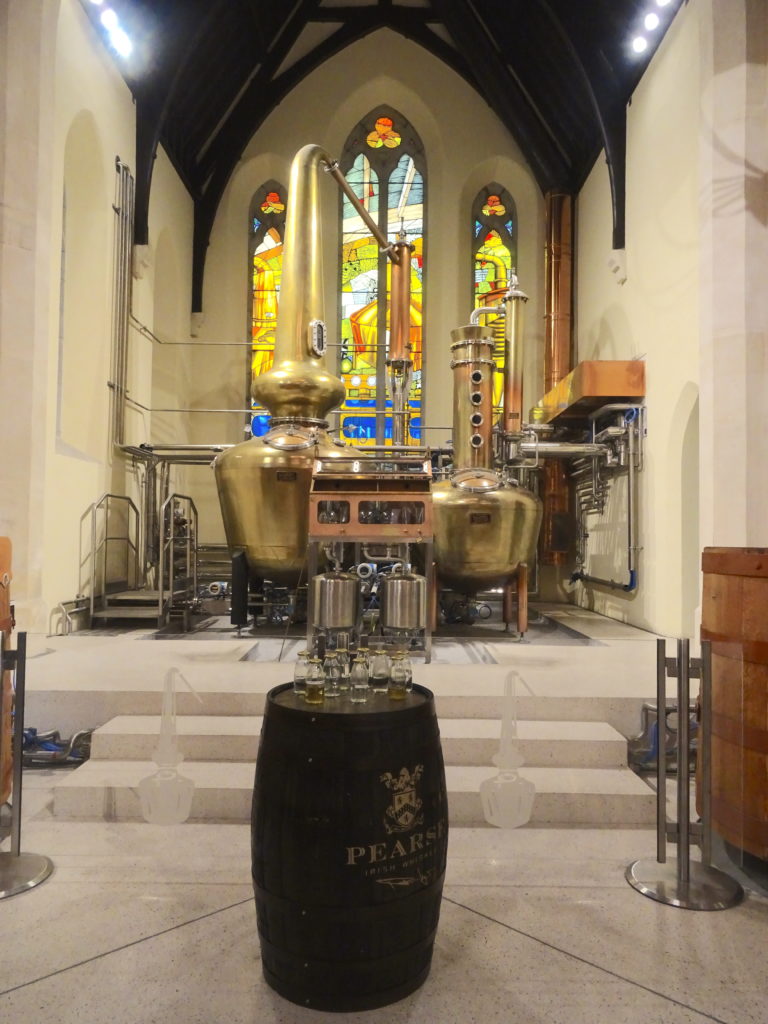
You Can Easily Tell Molly And Lizzie Apart
The larger of the two, Might Molly, is the wash still. The wash is heated within Molly to 85℃. This causes the alcohol to evaporate. The evaporated alcohol condenses in the neck and is called the Low Wine. This is only about 20% alcohol, which is still too low to be a whiskey, which has to be over 40%.
Now Little Lizzie comes into play. This smaller still is the spirit still. The low wine is distilled in this still, which is heated. Little Lizzie can do triple distilling and 2.5 distilling. In Lizzie, the low wines are separated into heads, spirit and tails. David passed around jars containing samples of these as he talked so that we could smell the differences.
At 66℃ the heads evaporate off. This spirit is 70% proof and is not for drinking. It contains methanol which can make you blind. The heads go back into the still and are redistilled.
The middle section of the liquid is the spirit. This evaporates at 70℃ and is the part that is taken out for maturation.
Lastly, there are the tails, which evaporates at 90℃. This part is only about 20% alcohol and is redistilled with the heads. There is normally a small part of tails in new-made spirits.
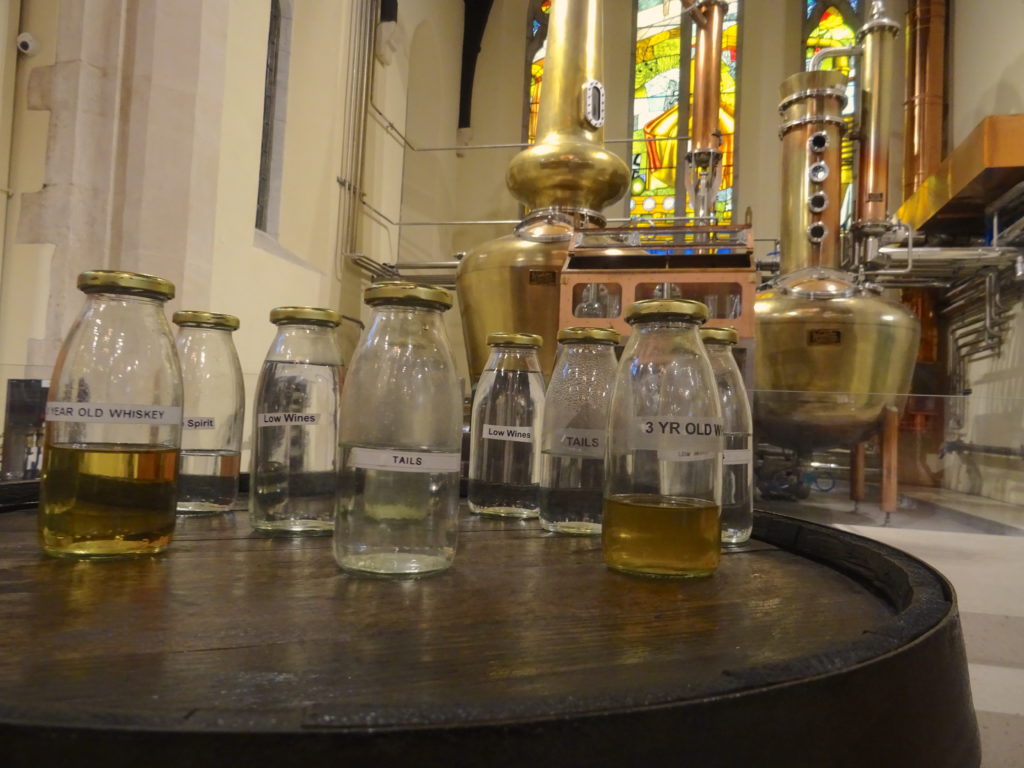
Jars Of Samples Of The Different Parts Of The Whiskey Making Process
With all this stilling and redistilling, you don’t get the same amount out that you put in. In fact, 1000l of wash makes only about 200l of spirit.
Maturation
The spirit from Little Lizzie is then put into barrels to mature. The barrels used at Pearse Lyons are from Kentucky. These are ex-bourbon barrels and are made from white oak. When making bourbon, the barrels can only be used once, but Irish whiskey can use these ex-bourbon barrels thrice.
To be Irish Whiskey, the liquid has to be matured for three years and a day. At Pearse Lyons, the liquid is matured for at least five.
During the ageing process, the liquid turns into its’ distinctive golden colour. Some of the liquid is also lost during the maturation process. So the longer it is matured, the less end product there is, which is why a whiskey that has been matured for longer tends to be more expensive than those that have been aged for a shorter time.
Liquid is lost from evaporation, which is called the “Angels’ Share”. Some is also absorbed into the wood. This is known as the “Devil’s Cut”.
Whiskey Tastings
Now it was time for some tastings. There were three types of tastings, this is where the wristbands that we were given with our tickets came into play. Depending on the tour booked you either taste one, five or six drinks. Those with only one tasting had come from the Big Bus Tour. We were on the Legacy Experience, which meant we got to sample everything. Our black wristband showed that we were on this tour.
I must say, from this tour it seems that Irish Whiskey distilleries are much more generous than there Scottish counterparts. In Scotland, I’ve only ever had two samples at a distillery and these wouldn’t normally be a proper measure. So to have six full measures at a distillery tour, just wow. Well worth it!
The tastings were all set up and ready for us. Those of us with the Legacy Experience were set up around the bar. The whiskeys were placed on mats, which labelled each one and had guides to each whiskey on the back. Those with only one tasting were on tables behind us. So you literally get the best seats on the Legacy Experience, not just a taste of all the whiskey.
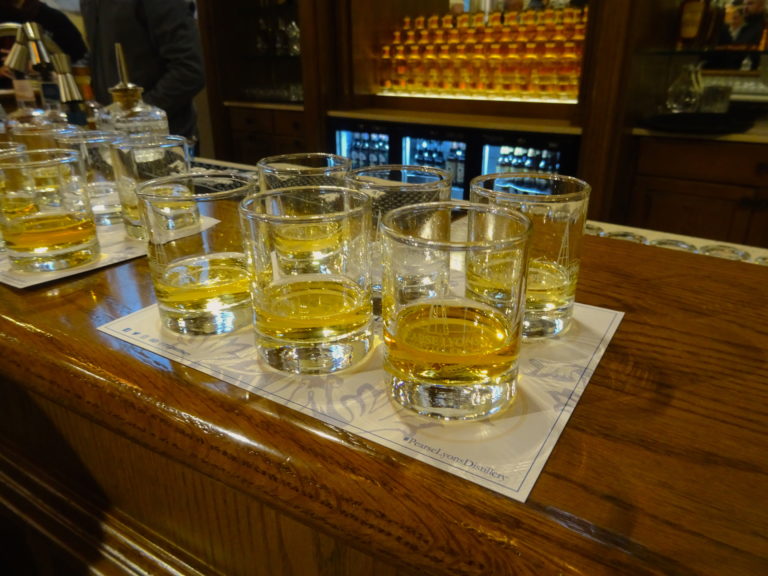
The Irish Whiskey Samples, That’s Quite A Bit Of Whiskey To Try!
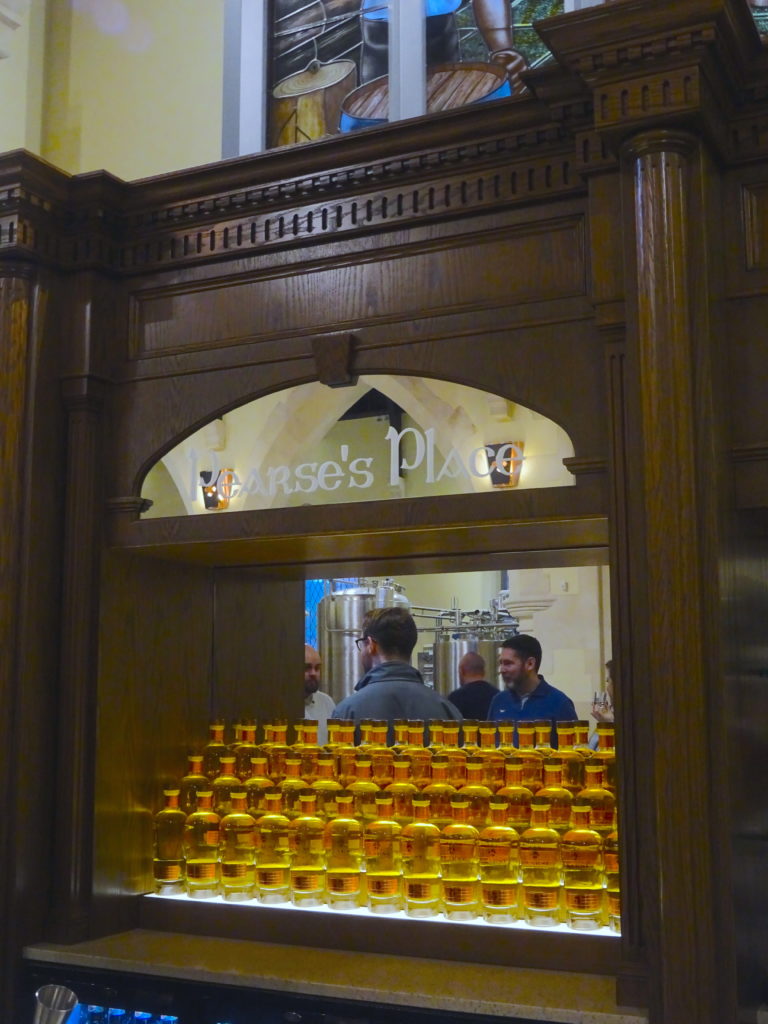
The Bar Itself IS Stunning
The bar itself is stunning. Made from wood, with a stain-glassed window above, it fits in well with the rest of the church.
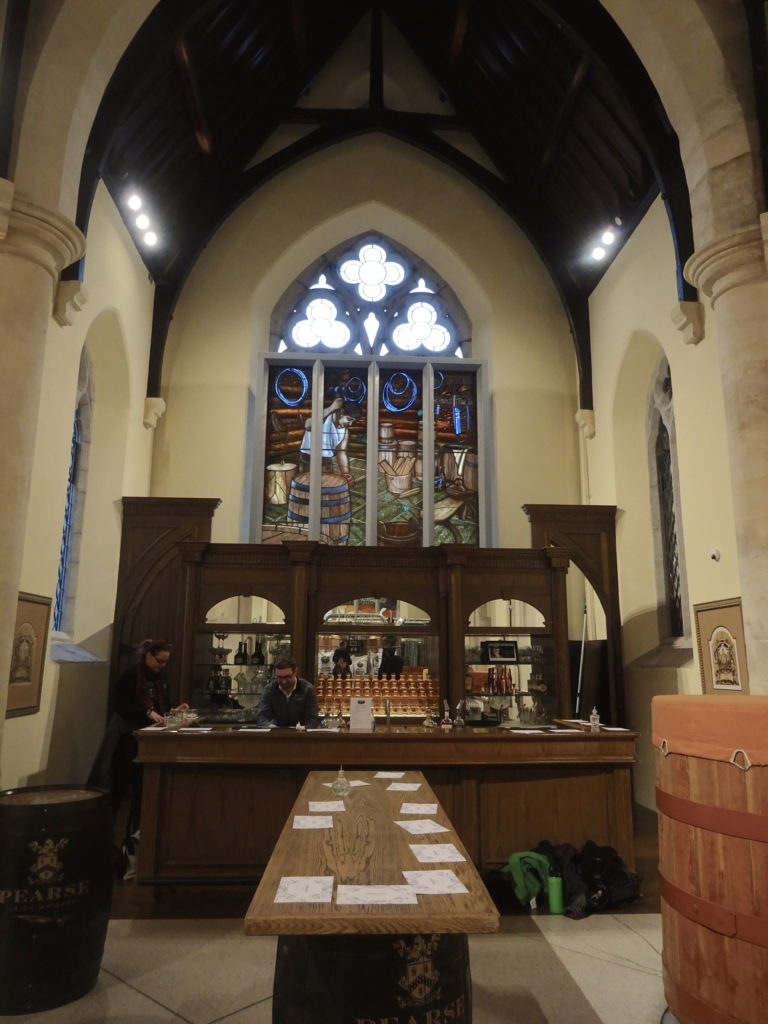
All Set Up For Whiskey Tastings
Pearse Lyons Whiskey
Before we started sipping, David explained to us the correct way to drink whiskey. First of all, you are meant to smell the whiskey to discover the nose. Then when you sip you allow the whiskey to sit on your tongue for five seconds before swallowing. If you find the whiskey is too strong you can add a dash of water.
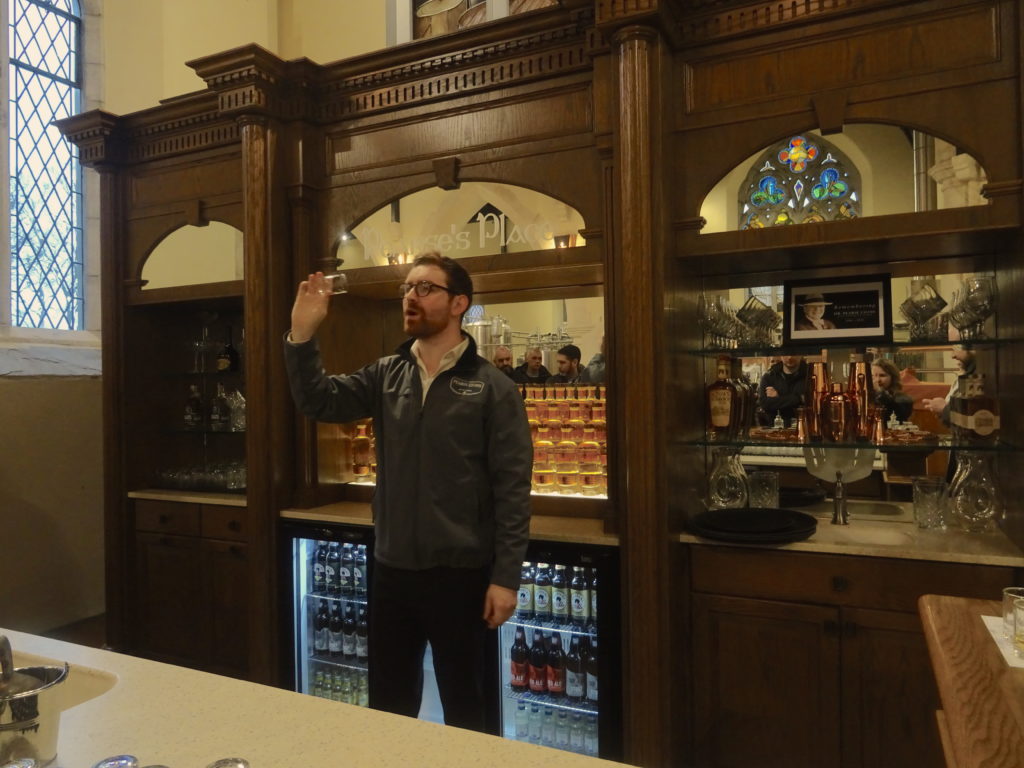
David Explaining About The Whiskey
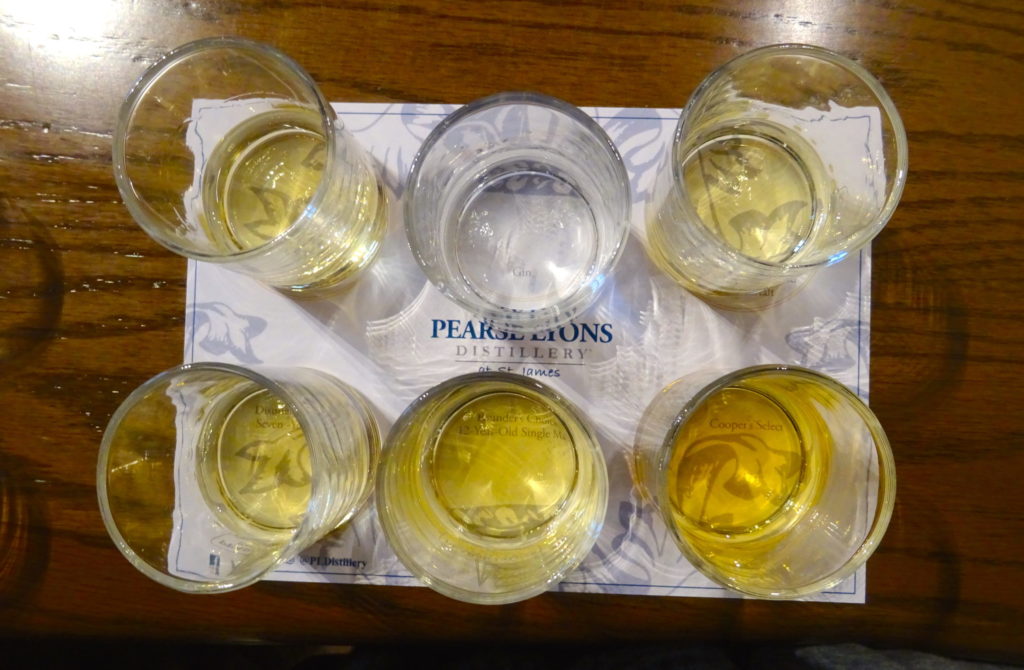
Our Whiskey Was All Labelled
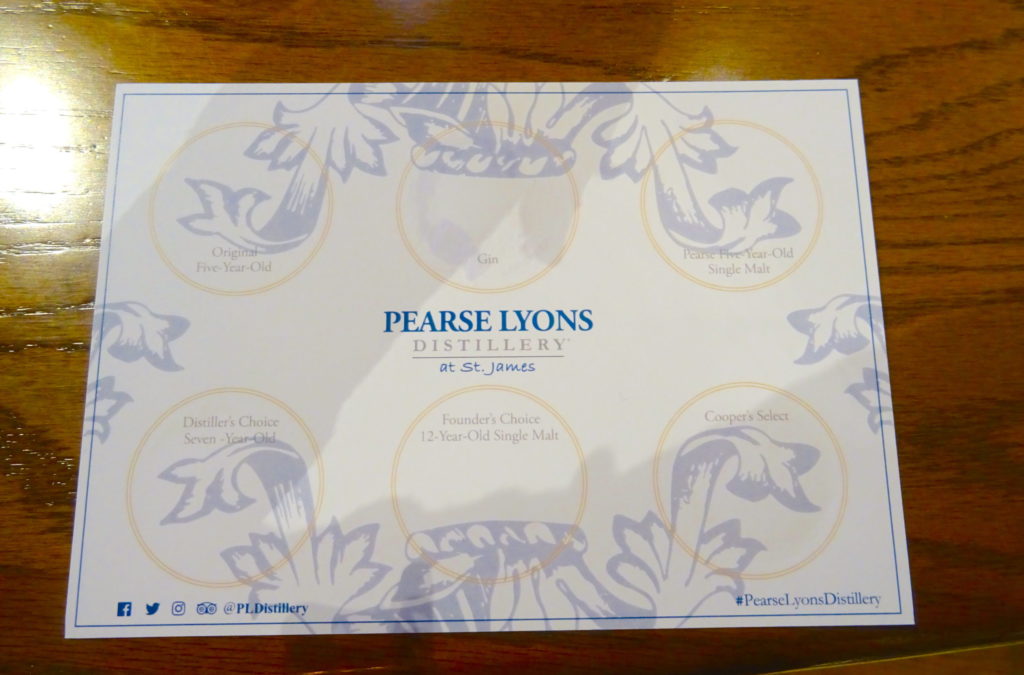
The Mats Had All The Whiskeys Labelled
We started with the whiskey on the top left of the mat. This is the Original Blend, which is a five-year-old blended whiskey. It is 43% proof and has a slightly citrus nose. The taste is of malt biscuit.
The next whiskey in the sampling was on the bottom left. This was another blend, but this time a seven-year-old blend. It is called Distiller’s Choice and is also 43% proof. The nose of this whiskey was more citrusy, orange peel and gingerbread. Cream and oak spice came through when tasting.
When The Maths Doesn’t Add Up
Now it became clear that we were going anti-clockwise around the mat, as next was the whiskey in the middle of the bottom row. Called Founder’s Choice, this was a twelve-year-old single malt.
But, at the time of my visit (2019), the distillery had only been distilling for six years (as distilling began here in 2013). So how can they have a twelve-year-old malt? The answer is simple, it was distilled and then matured in another distillery for six years and patented. It was moved to Pearse Lyons to finish it’s maturation once the church was ready. In a way, it was a “happy accident”.
Out of the first three whiskeys, this was the best. It has a herbal and fruity nose. The taste is of ginger, baked apple and honey, it was very smooth too. This whiskey is also 43% alcohol.
My Favourite
Next up was what became my favourite out of all the whiskey samples. This one was Cooper’s Select which occupied the bottom right of the placemat. A seven-year blend, this whiskey has been aged in a bourbon barrel for four years and then moved into a sherry barrel for the final three. David described this one as a “dessert whiskey”. It was also one of their limited edition whiskeys and so is not available anymore.
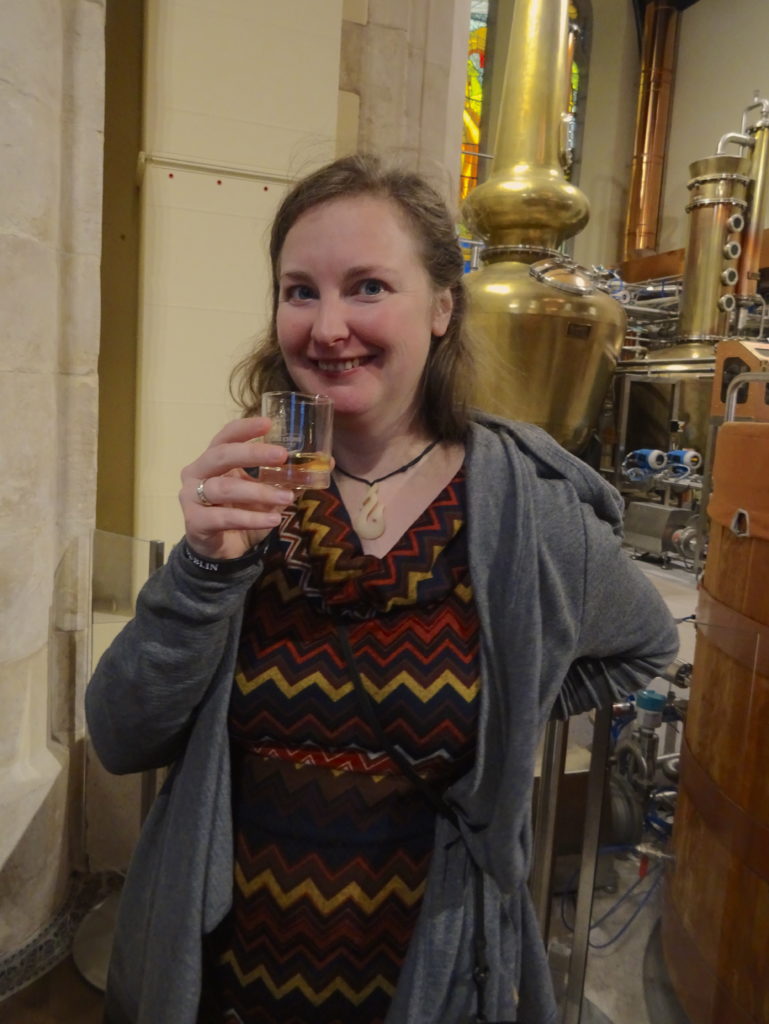
Enjoying The Whiskey At Pearse Lyons
This whiskey had a citrus nose, like orange and lemon peel with a bit of gingerbread. The whiskey was very smooth and had a vanilla and peach taste, with some oak spice. This was 42% proof.
On the top right was our final whiskey, a Five-Year Single Malt, also known as Legacy. This was the first five-year-old single malt whiskey to be made in a new distillery in Ireland for over twenty years. There are nine circles on the bottle, these represent the nine family members buried in the graveyard.
The nose of this whiskey is lighter, more like candied fruit, vanilla and cloves. This was the strongest of the whiskeys, being 46%. On tasting the whiskey is more delicate. Green apple, clove and a bit of pepper the taste was different from the others. David told us that this is a “teaser for what is to come”.
It’s Not Over Yet
Just because we’d finished with the whiskey, didn’t mean that the tastings were over, we still had the top middle to taste. This was a gin.
As whiskey has to be matured for so long, many distilleries will also make a gin, at least for the early years. Gin is much quicker to make and so allows the distillery to make some money before the whiskey is ready. Pearse Lyons did this.
The gin from Pearse Lyons is called Mil and has won some Gin Awards. I loved the bottle of this gin, so decorative. The name Mil comes from Irish legend, Mil is a mythological warrior who came over and fought the Irish. All the Irish are believed to be his descendants.
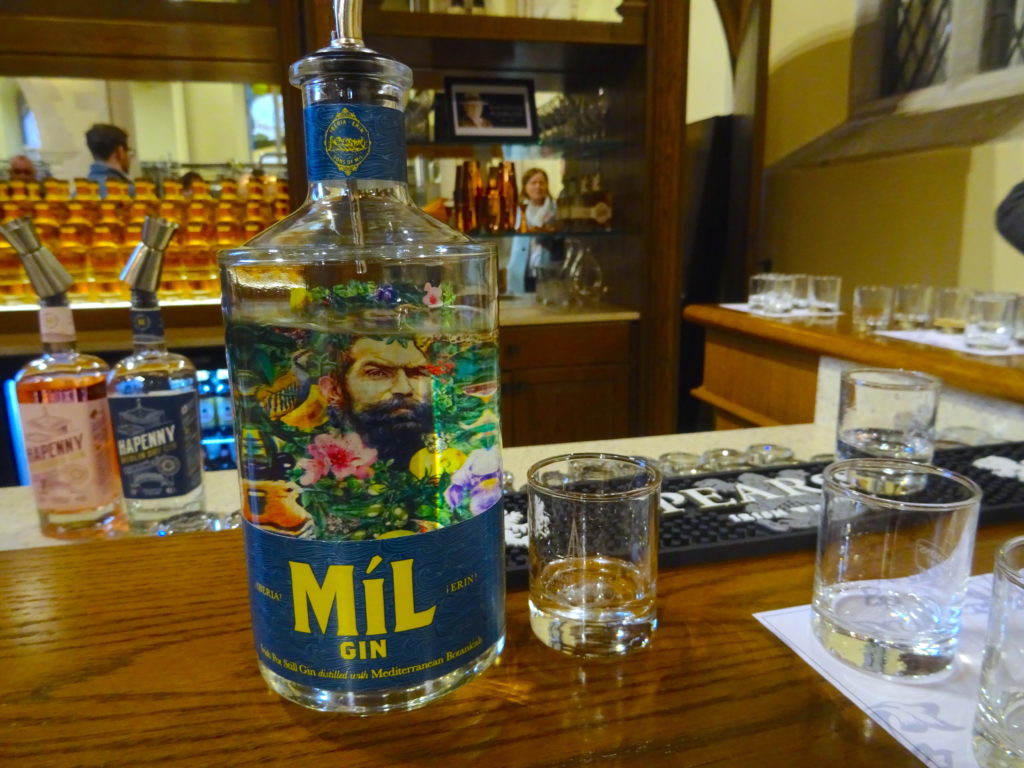
Pearse Lyons Also Make Gin
I’m not really a gin lover, but this gin I really did like. I can see a pattern here, as the only other gin I have liked was from a Scottish whiskey distillery, Harris Distillery.
Time To Wander
With the gin tasting, the tour was over. We sat and chatted to David for a bit until he had to go to take care of other duties. We were allowed to wander around the church and graveyard as much as we wanted after the tour.
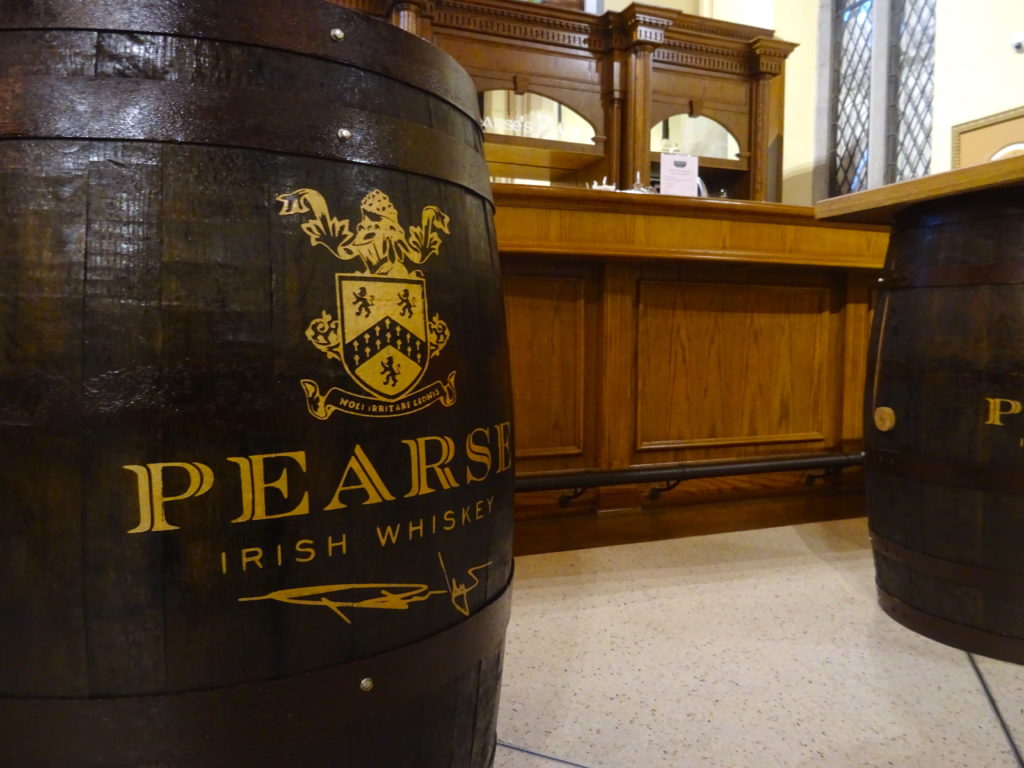
Although The Tour Was Over We Were Able To Sit At The Tables Whilst We Finished Our Samples
I’m glad we were able to stay for a bit, instead of being ushered out, as I still had some whiskey to drink! The tastings were pretty quick, and I’m rather slow when it comes to drinking whiskey. So we wandered in the church for a bit, still admiring the building. There are some barrel tables that can be sat at too. I think it’s a common occurrence that people need a bit more time to finish their samples!
After our whiskey was finished we had a nosey around the shop and had a chat with the guy on the till. He knew a lot too and told us even more. One thing that he told us was that Jameson was actually born in Scotland!
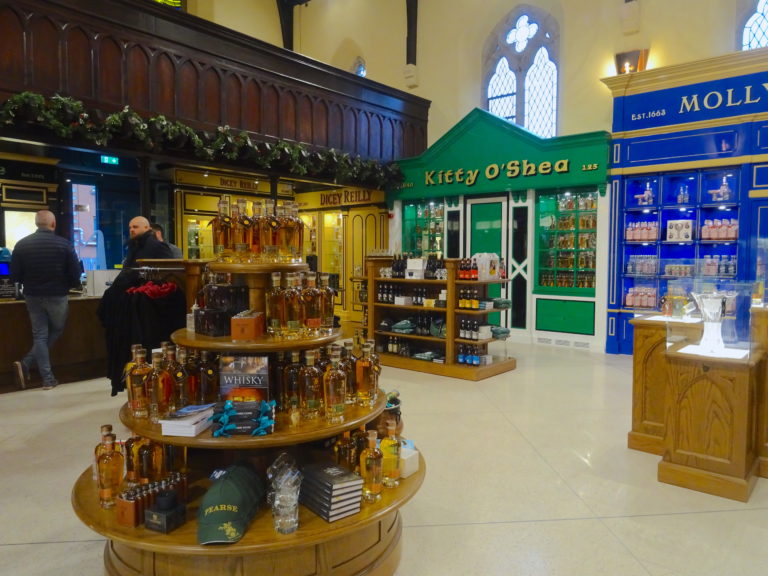
The Distillery Has The Shop In The Same Room
A Little Extra
When we went out of St James’ via the shop, we were still in the distillery grounds. You can walk all the way around the church, though you can’t go fully into the graveyard. As it was winter, we were the only ones from our group who took the time to wander a little. Some of the stained-glass windows look stunning from the outside.
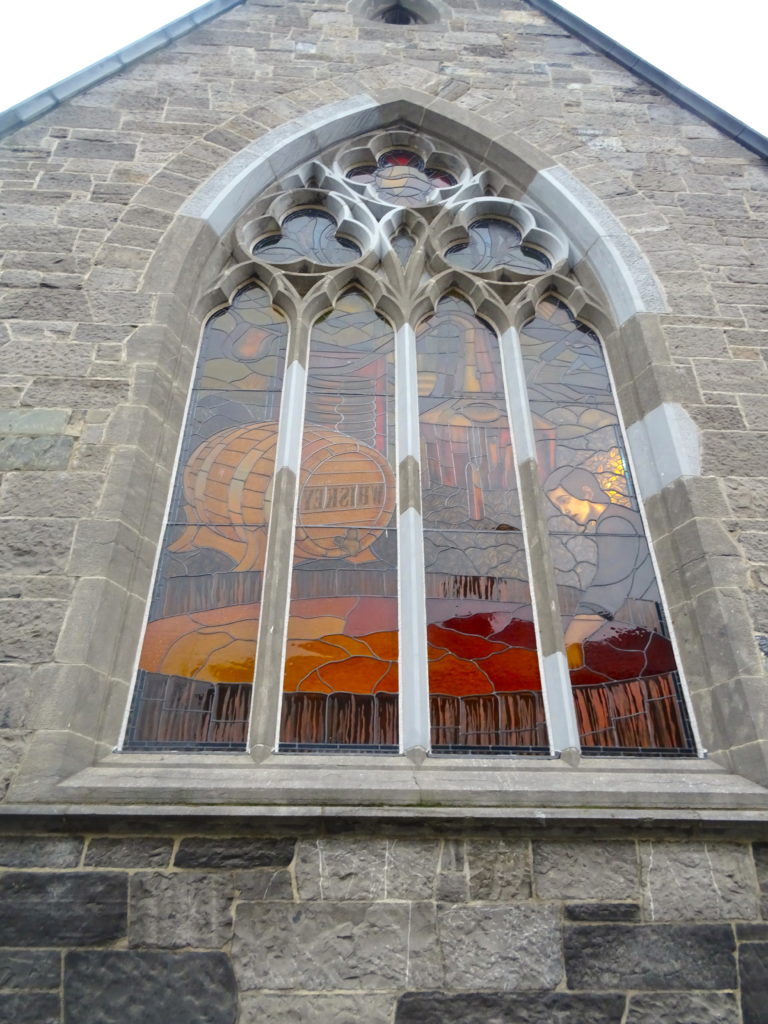
The Stained Glass Windows Were Beautiful From Outside
Leaving Pearse Lyons (after mooching around for a while), we went to the bar next door, McCann (click here for reviews). With your ticket from Pearse Lyons Distillery, you get 50% off certain drinks. As we knew we wouldn’t be coming into this area again on our trip, we couldn’t waste that offer now, could we?
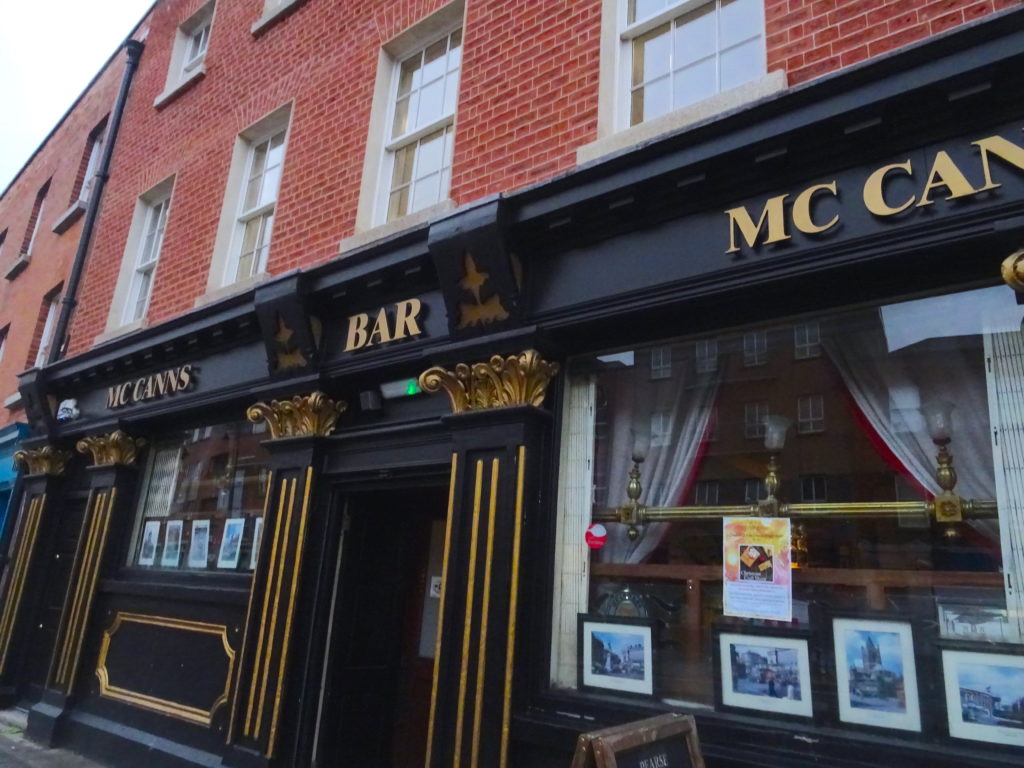
With A Discount At The Bar Next Door We Couldn’t Say No To Another Drink
Inspired to do the tour at Pearse Lyons Distillery? You can book a tour on Get Your Guide. Or if you’re looking for other tours in Dublin, click here. For accommodation in Dublin check out HostelWorld.
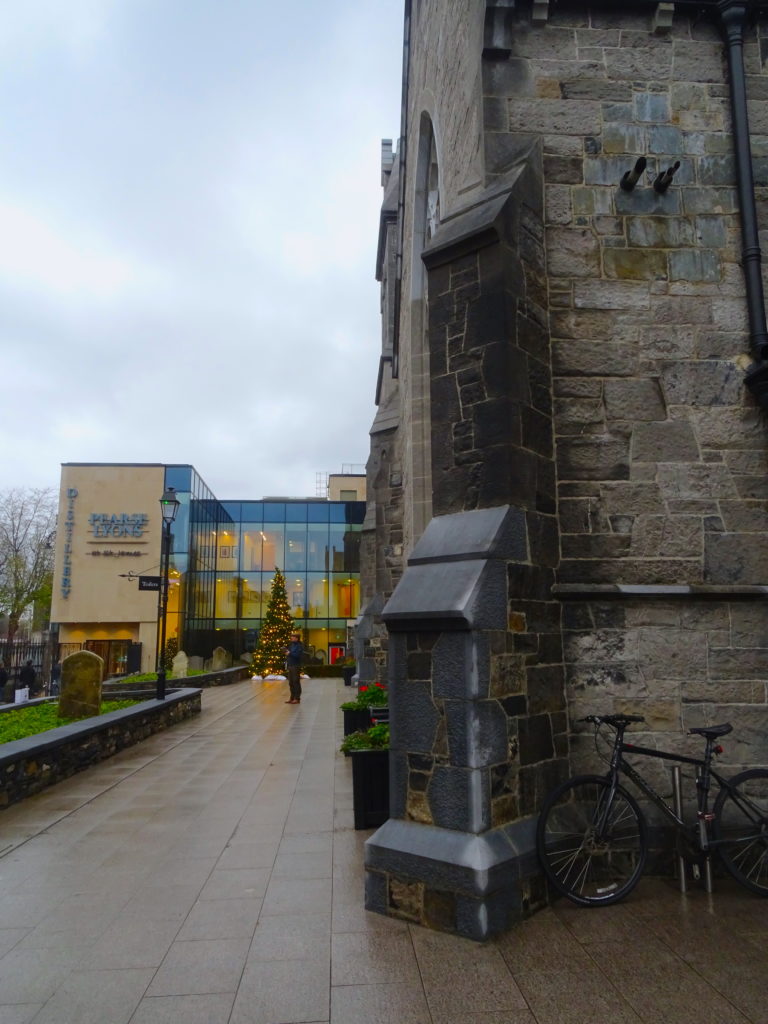
I Thoroughly Enjoyed My Pearse Lyons Distillery Tour

